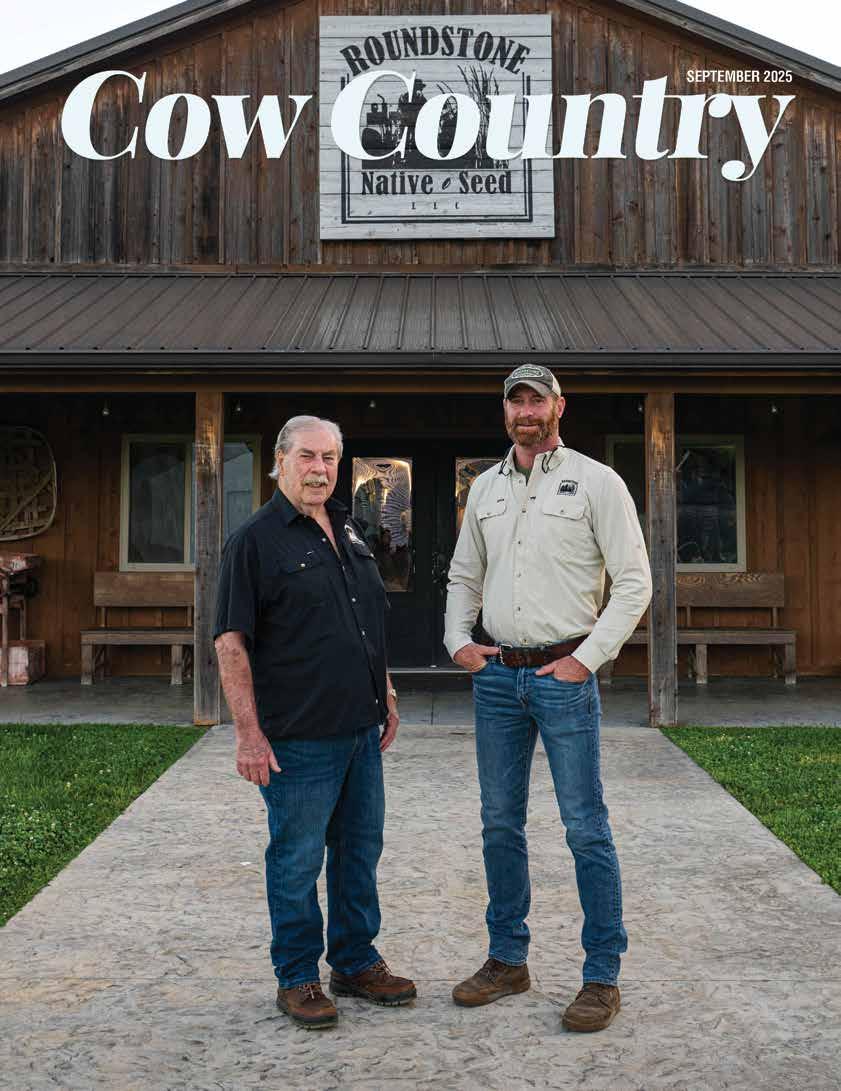

Myers Angus Farm and Tamme Valley Farm
“Family Values” FEMALE PRODUCTION SALE
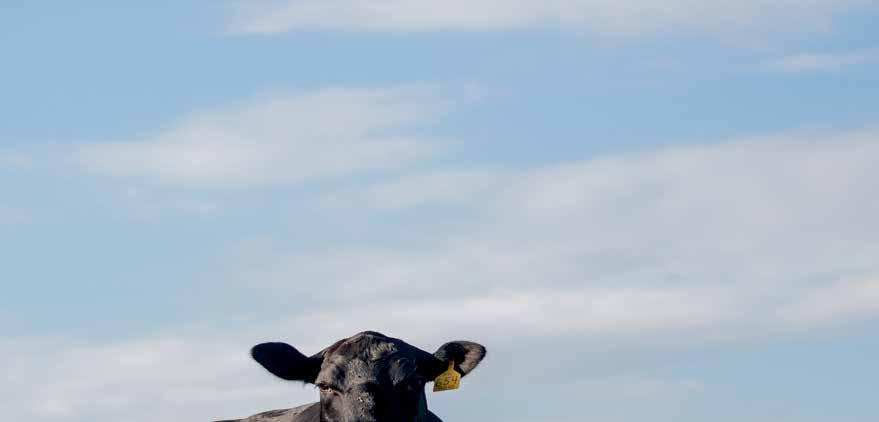
10 I 17 I 25

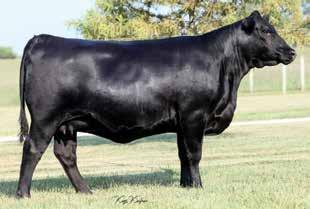
MYERS LUCY M034
20937933 • 1/10/24
This bred heifer is a daughter of Connealy Commerce whose dam, Myers Lucy M260, has been very influential in the Myers program where she has produced several past sale features. Due to calve 1/24/26 KCF BENNETT CULMINATION.
Friday Evening, 5:30 PM (EST) Held at Myers Angus Farm, Harrodsburg, KY
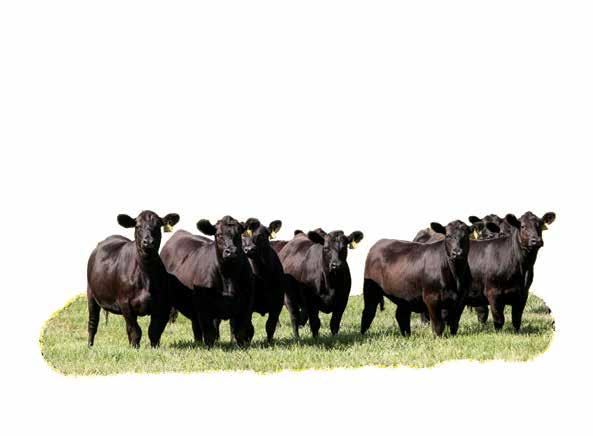
MYERS BLACKBIRD M483
20799368 • 9/10/23
One of the most anticipated production sales each fall!
Proven Donors
Replacement Heifer Calves
Spring Bred Heifers
• Spring Bred Cows
• Fall Cow/Calf Pairs
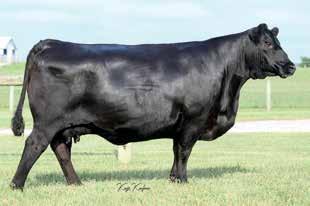
MYERS ISABEL M159
19418339 • 2/26/19

This direct daughter of the elite “Cow Maker”, TEX Playbook 5437 will be one of many proven spring calving females selling. Her spring born BULL calf by Baldridge Heat Seeker also sells. She is due to calve 1/20/26 to CONNEALY VALIDATION.

Several excellent young fall pairs will be selling, including this two-year-old Baldridge Gibson G859 daughter whose Sitz Stellar 726D dam is a maternal sister to Tehama Tahoe B767. She will have a calf at side sired by CONNEALY COMMERCE. TV KILDONAN ERICA T925
19724833 • 9/30/19
Several foundation quality females will be selling, both spring and fall calving, including this high maternal daughter of JVC Cavalry V3326 from the popular Kildonan Erica family. She will have a calf at side sired by VIRGINIA TECH STATESMAN.



1186 Curry Pike
Harrodsburg, KY 40330
David Myers
Colby Myers 859-325-1170
Joe Myers 859-265-0097
Tim Shepherd
Cow Herd 859-265-7804
www.myersangusfarm.com
Email: jmyers@selectsires.com

34 Dr. Michelle Arnold Frequently Asked Questions about Harmful Algal Blooms (HABs) in Farm Ponds Used to Water Livestock
38 Chris Teutsch Reducing Hay Feeding…Stockpiling and Winter Annuals
60 Kevin Laurent Managing the Details - Getting the Little Things Right
FEATURE STORIES
14 John and Randy Seymour Receive Kentucky Leopold Conservation Award
20 Class X Visits Colorado to Deepen Understanding of
30 Young Ambition
42 UK to Host September Grazing, Fencing Schools







I grew up in a household where my father instilled in me the impression that with a bit of hard work, I could accomplish anything. Nothing was impossible; it just may take more resources than it is worth. When I returned to the operation after four years of undergraduate work and two years of graduate studies, I brought with me some ideas. The ideas I had were often well-received. Even if he knew it wouldn’t work before I went through the thought exercise, he let me get to that conclusion on my own. There was one thing that he didn’t let me go through the process, and stopped me in my tracks. Freezer beef. I brought up the idea of direct marketing beef, and he simply told me that it was a fool’s errand. That was pretty much the end of the conversation. With the evolution of direct-to-consumer marketing over the last thirteen years, this didn’t seem like that hair-brained idea. However, in the context of time, it was a significant step to sell frozen meat and make a substantial living from it. In 2013, it did feel like the options were to try and develop demand at the farmers market $10 at a time every weekend morning, or to scale up and be on a restaurant’s menu. Fast-forward to 2019, and we had one single 900 lb. heifer that didn’t breed. As a single, at that weight, she wasn’t worth much in Kentucky. Given she was my heifer and I had a relationship with a manager at a processor through our county cattleman’s association, I thought, let me just process one for ourselves and see if I can’t sell enough to eat some steaks for free. Without boring you with the details, I was proficient in feeding, dictating the cut sheet, and distributing it to a customer base. What became one heifer, then two, then five at once, I was moving any cull animal that could grade USDA choice or higher through a freezer. I could tell from the beginning that he bemoaned every time I needed a half-day off from the “real work” to manage my freezer beef endeavor. There came a switch. The cattle were leaving, the freezers were empty, and I seemed to always need to make a bank deposit or a delivery. He realized I was selling his young cull cattle in a freezer for as much or more than we were selling performance-tested bulls and females. Suddenly, he was the one with ideas about how to increase the revenue of a beef operation, and I was the “expert.” He thought that we needed to start taking our older cull cows to the processor to sell as ground beef. I knew before the sentence left his lips that my immediate answer was going to be no. It doesn’t matter if it is a USDA prime steer or a cull cow, my processor is going to charge me the same to process them. You don’t have to have sold freezer beef to know that 500 lbs. of steaks, roasts, and grind from a prime steer is worth significantly more than 500 lbs. of grind from a pasture fat cull cow. The lesson I have tried to illustrate in the last 500 words is that the best ones cost just as much to work with as the “bad” ones. In

today’s cattle market, it may seem like any cow can make you money. All she has to do is give you a live calf. While $2,000 weaned calves seem like a meal ticket all day long, we are forgetting that we have $ 20,000 or more invested in every cow-calf unit. If you have 25 cows, you probably wouldn’t sell me your farm, truck, trailer, tractor, and cows for $500,000. I have never had anyone dispute that number when I say it. More often than not, they tell me the number is higher. When you are putting $500,000 in capital to work on a set of 25 cows in a breeding group, does it matter if that bull was $4,000, $5,000 $7,000, or $8,000? A $1,000 difference in purchase price on a herd bull is $10 per calf. That is less than 0.5% of the value of each weaned calf. The beef supply chain is currently harvesting as many cattle as we can until at least 2027. We will eventually expand, and that will require retaining heifers. They will be the highest priced replacement heifers you have ever kept. Based on economic selection indexes, our average bull will give you daughters that are $35 more profitable per calf to the commercial producer at weaning than those of the average Angus bull. We have bulls in our fall sale that will produce daughters with calves that are more profitable by over $60 per calf than the average registered Angus bull. They do this while maintaining breed average carcass value and marbling. The best ones cost just as much to work with as the bad ones. These prices make geniuses of all of us. These prices won’t always be there. We need cows that show up every year, don’t give you problems, and raise a calf the market wants to buy. When things normalize, we will find out quickly who took the profits to reinvest in their cow herd and who took the money and ran. You have $20,000 of capital at risk in that replacement heifer. Does it really matter if she cost $20 more because you bought the bull you needed?
- Joe K. Lowe II

EXECUTIVE COMMITTEE
OFFICERS:
President
RANDY WARNER Sharpsburg
President Elect
ALLAN BRYANT Eminence
Vice President
DANIEL HAYDEN Whitesville
Treasurer
KEN ADAMS Upton
Past President
JEFF PETTIT Sebree
KCA Program Chairman
ADAM CHUNGLO Harrodsburg
KBC Chairman
RYAN MILLER Campbellsville
KBN Chairman*
ALLAN BRYANT
Beef Solutions Chairman*
DANIEL HAYDEN *ex officio
REGIONAL DIRECTORS:
REGION 1
Wayne Zoglmann, John Mark Brown, Dale Gold, Greg Roberson, Gary Woodall, Coleman Ladd, Susan Zoglmann, Bill Plemmons, Kenton Howard, Steve Dunning, Conner Williams
REGION 2
Phyllis Gentry, Joe Lowe, Allison Nissley, Rayetta Boone, Robbie Hatfield, Chris Imbruglio, Maggie Webb, Andy Joe Moore, Adam Thomas, AJ Mitchell, Isaac Thompson, Kenneth Green, Trent Jones, Josh Morris, Joe Mike Moore, Amy Cecil
REGION 3
Amanda Hall, Nathan Lawson, Allen Phillips, Irvin Kupper, John David Yount, Lincoln Clifford, Abbey Biddle, Ben Tinsley, Crystal Harrod, Kyle Bush, Michelle Simon, Craig Retzlaff
REGION 4
Amy White, Brad Reynolds, Chad Anglin, Phillip Stamm, Danielle Harmon, Brandy Graves, Jodi Purvis, Mike Ravencraft, Ronnie Lowe, Logan Carter, Jason Crowe, Rob Amburgey
REGION 5
Phillip Reese, John Settles, Natalie Wesley, Doris Hamilton, Freddy Harris, Brent Williams, Anne Bays, Tommy Glasscock, Josh Wethington, Arch Sebastian, Terry Mattingly Executive Committee members in bold
KCA PAST PRESIDENTS:
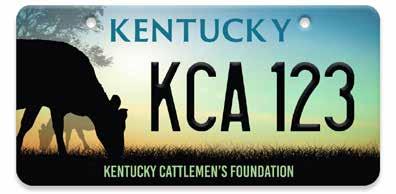
Dave Maples
Kenny
Kelly
Todd Brown Graphic Designer
Bradon Burks KBC Director
Rachel Cain Membership and Communications Coordinator
Amelia Carter KBC Director of Industry Relations
Danny Coy Video Production Specialist
Jake Harrod KBN Program Coordinator
Dan Miller KBN Industry Coordinator
Debby Nichols National Advertising Sales, LAN
Katie Pratt Communications Manager
Alex Scott MS, RD, LD KBC Southeast
Becky Thompson Director of Kentucky Beef Network
Kelly Tucker KCA Collections & Compliance
Nikki Whitaker Director of Operations & Policy
Kentucky Cattlemen's Foundation will receive $10 from each purchase and renewal to benefit education, leadership and youth programs.


President's Thoughts
Randy Warner KCA President
Well, here it is September. I hope that it finds you well , healthy and happy. On the farm, we have been really busy trying to get hay put in the barn around rain showers and the intense heat we had back at the end of July. I hope you all have had a fruitful harvest.
It’s been a busy month at the office as the Construction Oversight Committee finalized the floorplan for the new Livestock Innovation Center. While renderings are still to come, we’re excited about the progress and the impact this facility will have on the countryside of Versailles. There is one thing I hope we take away from this experience is the tremendous amount of work our staff has done to make this center something that is being talked about across the country. During our trip to San Diego for the NCBA Summer Business Meeting back in July I was asked on numerous occasions about when the center would be open for people to tour.
Also, while in San Diego many discussions centered on the invasive species, New World screwworm. Even though it’s thousands of miles from Kentucky, its effects are real and of concern for us. Just the mere mention of it in an article in Missouri caused panic in the U.S. futures markets. It’s something that is real and could be a detriment to all cattle producers if it reaches the United States.
Another thing that has been on my mind since taking the reins of this great organization that will resonate with a lot of people is we need more younger producers to take over for us. I for one know this first hand as I’m slowly but surely trying to teach my nephew Noah everything that I’ve learned over the last 60 plus years, and believe me learning to let go is one of the toughest lessons I’ve been taught. It’s not easy watching someone do things that you are used to doing for yourself and have done for years. I know it’s going to be hard, but if we show them and let them
be involved, they’ll carry on just like we do. I think my greatest legacy is going to be showing and participating in bringing up our next generation of young producers. They are going to make mistakes along the way but the important thing is that they learn from them. The only thing I need to warn everyone about is be prepared to help pay for the breakdowns and repairs that come when a young person begins to learn farming. Believe me, Noah and I have had our share of breakdowns− equipment and otherwise. Really that last part I say in jest, but let them learn. Sure, there are going be words said, but that is just normal for us.
In closing, please take this piece of advice and nurture our youth to effectively communicate with one another to make sure we are raising a most sustainable supply of beef that is the most nutritious protein that all consumers strive to serve to their families. God Bless, and you can always reach me with any questions or concerns. Thank You.


Commissioner's Corner
Jonathan Shell Agriculture Commissioner
An initiative focused on providing opportunities for Kentucky students to learn more about agriculture is returning the week of Sept. 15-19. Kentucky’s second statewide Agriculture Education Week will be more than teaching students where their food, fuel and fiber come from. Like the first Ag Ed Week last spring, the fall version will also introduce them to career opportunities that agriculture offers and will seek to inspire them to be a part of its future.
Agriculture Education Week is a bipartisan collaboration between the Kentucky Department of Agriculture, Kentucky Department of Education, and Lt. Gov. Jacqueline Coleman to equip educators with ready-to-use lessons and resources. There will be 16 initiatives that make this a wraparound approach to agriculture education, starting from the moment the students enter school to opportunities throughout the day in all subject areas, even in the lunchroom and outside the school day.
Teachers will not stop teaching their usual curriculum to teach agriculture. Instead, they will teach the curriculum through the lens of agriculture. In math, students will learn fractions while making salsa. In reading and writing, students will learn about beef production. In social studies, they will learn about regional ag production based on climate and topography. In science, they will learn the impact of science on agriculture in a multitude of ways.
Connecting agriculture to real life-skills by teaching nutrition, sustainability and how agriculture intersects with nearly every career field enhances students’ understanding about the importance and vast variety of agriculture fields. KDA’s Agriculture Education and
Outreach Division took feedback from the spring and doubled down – and then some. It’s ensuring that teachers have what they need without adding to their plates, students have access to agriculture education and the local community has opportunities to engage and showcase what agriculture looks like locally.
The initiative will foster community involvement to create dynamic, hands-on learning focused on the diverse world of Kentucky agriculture. KDA has about 300 farms and agribusinesses signed up to provide ag tours to classes through The Real Ag Experience. These field trips are not just for students aspiring to become farmers or working in the agriculture industry. It will help all students understand nutrition, sustainability and how agriculture intersects with other fields, including law, marketing, healthcare and communications, in addition to helping students grow into educated consumers.
Agriculture has a nearly $50 billion impact on Kentucky, which boasts the seventh-highest number of farms – nearly 70,000 – among the nation’s 50 states. Farmland comprises more than 12.4 million acres, making up nearly half of Kentucky’s total acreage.

THE YARDS is an education center focusing on the science and practices of the beef industry. Educational opportunities provide a unique learning experience based on its location in the Blue Grass Regional Stockyards Marketplace. This environment fosters complex thinking, experiential learning, and life skill application.
(859) 382-4303
Allison Charolais
Charolais Breeder Since •
Charolais Breeder Since 1962
Creating interest in agriculture prepares the next generation of farmers, scientists, business leaders and innovators who will keep Kentucky agriculture strong. Investing in education today ensures a thriving sustainable industry for tomorrow.
Ø Bull calves out of HCR Answer HCR SPIRIT 4007. Ø Bred for calving ease and growth.
4007.
Ø Bull calves out of HCR Answer 2042 and HCR SPIRIT 4007.
Ø Bred for calving ease and growth.
Ø Bred for calving ease and growth.
Ø Bulls for both purebred and commercial breeders. Ø Yearlings and two-year-olds available.
Ø Bulls for both purebred and commercial Ø Yearlings and two-year-olds available.
Ø Bulls for both purebred and commercial breeders.
For more information on Agriculture Education Week, the history and diversity of Kentucky agriculture lesson plans and resources and how you can get involved in this initiative, visit www.kyagr.com/AgEdWeek.
Ø Bred heifers to calve in fall available.
Ø Bred heifers to calve in fall available.
Ø Yearlings and two-year-olds available.
Ø Bred heifers to calve in fall available.
John Allison, Owner 545 Eminence Road New Castle, KY 40050 502-220-3170 David Carter, 502-706-0075
John Allison, Owner 545 Eminence Road New Castle, KY 40050 502-220-3170 David Carter, Farm Manager 502-706-0075


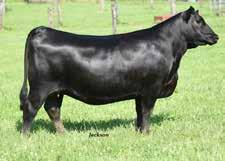







Thoughts From Dave
Dave Maples Executive Vice President
It all started with the request for a letter. I called Dell King in April 1999 and ask him if he would write a recommendation letter for Autauga Farming Company one of the farms that I has working with for a national award. Dell said “Yes, but…,” and the phone got silent for what seemed like two minutes before he explained the “but.” Then he said, “if you will apply for the executive VP job at the Kentucky Cattlemen’s Association.”
From that day in April to June 1999 was a very emotional time for my family. There was a great deal of back and forth. The initial offer was not very appealing for a young family to move 500 miles from a secure and familiar location. I remember Dell making the statement that this negotiation was like trading a load of cattle. He got serious. Then, he got real, and we made a deal. My family has been in Lexington for 26 years.
It was ironic to me that the owner and former manager of Prattville, Alabama-based Autauga Farming Company were at Dell King’s funeral in Nashville, Tennessee in early August.
Dell King formed King Livestock, a Hopkinsville, Kentucky cattle marketing company in 1968. In Dell’s heyday,

the company move thousands of cattle out of Western Kentucky, Tennessee, Alabama, Georgia, Florida and other southeastern states. His son, Chuck and his wife, Cissy, are now owners of the company.
your new third hand!
A better grip on Bovine Rubber Band Castration
• Holds both testicles securely
• Reduces slips & missed castrations
• Minimizes stress on calves & handlers

Now available for calves under 2 weeks old and also in a mini size for lambs and goats.
Find it at your favorite ag retail store or animal health supplier.
One of the photographs that I am most proud of since I became executive vice president of KCA was taken with me standing between Dell King and the late Gene Barber, one of the owners of Blue Grass Stockyards. Both were big men in stature, and both were big men in the cattle marketing business. Both had a very intimidating first impression, but deep down, they were very compassionate. They were fierce competitors but had high respect for each other. I really don’t know how I gained the confidence of both these men, but by doing so, it made my job at the Kentucky Cattlemen’s Association really possible. You may or may not know this, but Kentucky is not an easy state to be a cattlemen’s association employee in. There is so much competition in the cattle marketing world in Kentucky and to be able to communicate with each of these firms is not an easy task. I can tell you I have been on the wrong end of the conversation with both of these men, and honestly, really with just about each of the owners of all our Kentucky marketing firms. I remember each one of those conversations. I think those conversations (ass chewings) had a big impact on who I am. Most of the time when these conversations were over, there was a respectful bond that was formed between us. Those guys were tough but fair with me.
I can only imagine what they would be saying about today’s cattle prices. It would be fun to have a conversation about all the record highs including record carcass weights, record number of cattle with 150 days on feed or more and huge beef imports. The cattle market has been in a long-term uptrend for over five years now. That, too is a new record. The industry seems to be in a “perfect storm” bull market with resilient domestic beef demand, improved pasture conditions, plentiful hay and the loss of a major feeder cattle supplier (Mexico), to name a few.
Dell King, Gene Barber and several others who I’ve not named, have really shaped my time as KCA executive vice president as my mentors, industry leaders and sometimes as my fiercest critics. I’m very grateful Dell asked me to apply for this job 26 years ago as it has given me numerous opportunities to be a proactive voice for the state’s cattle producers.
You can read more about Dell in his obituary on page 13.
Foundation Sale The
Saturday, September 20, 2025 1pm cdt United Producers Facility, Bowling Green Kentucky 42101
FULLBLOOD LIMOUSIN, RED & BLACK, PUREBRED LIMOUSIN CONSIGNORS FROM KENTUCKY, TENNESSEE, OHIO, GEORGIA, MISSOURI
Discover What Limousin Genetics Can Do For Your Operation.
Whether you are looking to add pounds at weaning, increase yield on the rail, or improve maternal function, Limousin genetics offer:
Consignors
• Superior carcass yield
• Feed Efficiency that saves dollars
• Excellent maternal traits and docility
Explore what the Limousin breed can bring to Your Program

Marketing & Sales Team
Stephen Haynes…….………..……….(270) 799-8685
Emily Haynes…………………………..(270) 799-8684
Carter Haynes……………………........(270) 799-0196
Bill Helton (Helton Consulting)……….(256) 962-0256
Carrol T. Cannon (Auctioneer)……....(229) 881-0721
Dean Summerbell……………………..(612) 963-3799
Bev Summerbell……………………… (763) 232-9302

Helton
799-0196 Emily Haynes...............................................................................................................(270) 799-8684 Carrol T. Cannon (Auctioneer)………………………..................................................(229) 881-0721 Topshelf-auctions.com – Dan Wells (contact)…..........................................................(740) 505-3843
BARREN COUNTY NEWS
submitted by Ken Wininger & Carol Spiegl
Barren County Cattlemen's Association grilled ribeye sandwiches for the opening of Kentucky State University Cooperative Extension Service in Glasgow. Pictured are several members of BCCA, Glasgow Chamber of Commerce and Barren County Extension Service.
Barren County Cattlemen grilled ribeye sandwiches for a field day at Dennis Smith’s farm in Glasgow. The field day was sponsored by Corteva, a company focused on providing farmers with crop protection products.
Barren County Cattlemen's Association met on Aug. 7. The ribeye sandwich meal was sponsored by CPC Commodities, Fountain Run, KY. Jarrett Cockrill informed the membership of the upcoming fall field day. Barren County Cattlemen's Association thanks CPC for providing door prizes of cattle mineral gift certificates and company caps.

Barren Country Cattlemen's Association awarded two, $500 scholarships to students studying agriculture. The 2025 recipients are Ian Manion and Mollie Webb. Presenting the scholarship award is Ken Wininger, BCC board member
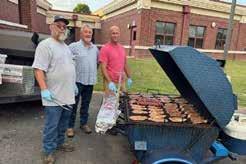
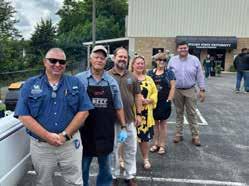
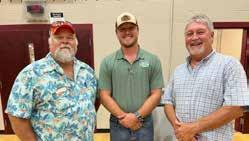
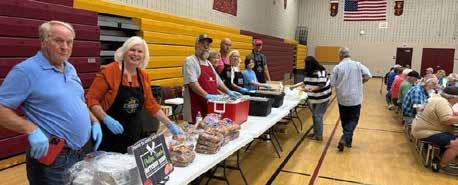
HARRISON COUNTY NEWS
submitted by Jessica Barnes
Each year, the Harrison County Beef Cattle Association (HCBCA) awards two Jay Ammerman Memorial scholarships to graduating seniors pursuing an ag-related degree. This year, we had excellent candidates, and the HCBCA board decided to award all three applicants $1,000 each. HCBCA President Keith Smith presented the three scholarships at the Harrison County Fair Beef Show. The 2025 Jay Ammerman Memorial Scholarship recipients are from left to right Aleya Nelson, John Michael Furnish and Clayton Laytart.
LINCOLN COUNTY NEWS
submitted by Tyler Miller
Beef was the choice of meat selected to feed the attendees that came out for the Lincoln County Field Day. Our cattlemen prepared the meal, and as always, it was excellent!
The field day was hosted by Chad McQueen and his family at their beef farm operation. They have a wonderful setup and a beautiful farm. Thank you to McQueen farms for hosting!

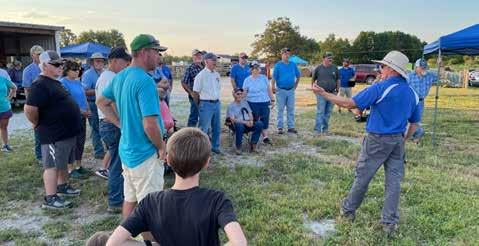
Steve Webb, BCC president, Jarrett Cockrill, CPC and Mark Crain, BCC Vice president
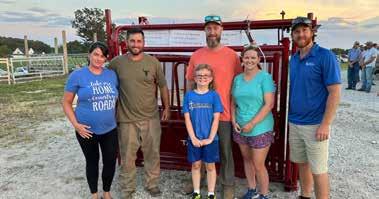
In-line bale feeders was one of the topics presented. Steve Higgins with the University of Kentucky spoke on the importance of improving your winter feeding system. He is top notch when it comes to design layout and making sure systems are built with the animal in mind. Thank you, Dr. Higgins.
The ones attending also got to view a live cattle working demo performed by Veterinarian Dr. Kevin Pettit. He did a great job showcasing how well thought out handling facilities not only keep you safe but the animal as well. He covered everything from safety features of the working facility to proper vaccinations, when and how to administer and the importance of record keeping. Dr. Pettit did a great job, and we thank him also for his time and expertise.
Meade Tractor of Danville was there to answer any questions and talk about the lineup of John Deere equipment that McQueen farms utilize. We appreciate them and all they do for our farming community. Wagon tours of the farm ran all evening, and the kids enjoyed a pedal pull. I love to see the smiles on their faces while they are out having fun on the farm!
The door prize for the event was a Tarter CattleMaster Series 3 squeeze chute. This was given away to one lucky winner. That happened to be a young farm family out of the Hubble community that is actively running a beef cow calf operation. Congratulations to Joseph and Krista Rankin!
We could not have received such a door prize without our very supportive sponsors. Thank you to Tarter Farm and Ranch, Ag Credit of Stanford, Southern States of Stanford, Lincoln County Farm Bureau Federation, Lincoln County Cattleman’s Association, Meade Tractor of Danville, Bluegrass South Livestock Market, Mayhaven Farms, Lake Cumberland Livestock Market and Southern States of Somerset.
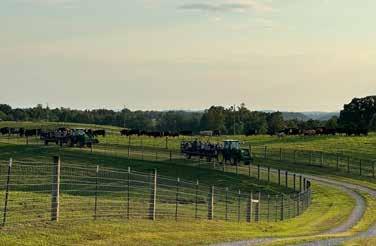

Leo Redell King, Jr. (Dell)
Dell was born May 5, 1938. He passed into the loving arms of our Lord and Savoir Jesus on July 26, 2025 at his home in Nashville, Tennessee. Dell was an only child. His parents Leo Redell, Sr. and Alice Marie King, grandson, Leo Redell King IV preceded him in death. He his survived by his loving family: wife, Nancy Jo King and his children, Karen Shoopman (Allen), Leo Redell King III “Chuck”(Mary “Cissy”) and Holly Shelly. His grandchildren, Jeff and Laura Shoopman, Ellery Naghtin (Andy) Lauren, Rachel and Anna Shelly. Great grandchildren, Eloise and Jack Naghtin. He is also survived by his beloved dog Nelly Jo.
Dell was a member of Woodmont Hills Church for over 35 years. He was very active in Sunday school class and Wednesday night Bible class.
After graduating from the University of Tennessee in 1960, Dell began his career in the cattle industry. He worked seven years for cattle and hog processing plants in Nashville and Clarksville, Tennessee. In 1968, Dell had the burning desire to start his own business and so the story of King Livestock Company began, a livestock buying firm in Hopkinsville, Kentucky. For several years he purchased and sold cattle and hogs. Over the years, the industry evolved and changed, and King Livestock Company did as well.
Dell’s specialty became going to farms and ranches all over the Southeast, working with the farmers to find places where they could get the best price for their cattle. Dell had a real love for people and always said,”It’s
not just about knowing the cattle, it’s all about knowing the people.”
Dell’s son Chuck was also very instrumental in making King Livestock Company one of the largest, cleanest and best livestock buying firms in the country. After 50 years, in 2018, Dell and Nancy retired. Chuck and Cissy now carry the tradition forward.
Dell was honored with many accomplishments and awards and was always willing to help in all aspects of the cattle industry. He was a Kentucky Colonel, President of Kentucky Cattlemen’s Association, first to be inducted into the Kentucky Cattlemen’s Hall of Fame, National Cattlemen’s Beef Quality Marketer of the year, listed as 17th in the top 50 Cattle Industry leaders in the country, board member of Beef Quality Assurance program, and founding developer of Livestock Quality Assurance Transportation Guide. He was a member of National Cattlemen’s Association, Kentucky Cattlemen’s Association, Alabama Cattlemen’s Association and Tennessee Cattlemen’s Association. He was featured in many cattle industry magazines.
Dell was an avid Kentucky basketball fan. He bled “Blue” through and through. He and Nancy loved following the “CATS” and made many great memories going to all the games.
Throughout his travels in the Southeast, he was able to witness to people about his faith in Jesus Christ. While he was humbled and thankful for his many awards and accomplishments, the most important thing in his life was his family and his faith in Jesus Christ. ⃣
John and Randy Seymour Receive Kentucky Leopold Conservation Award
John and Randy Seymour of Upton have been selected as the recipients of the 2025 Kentucky Leopold Conservation Award.
The award honors farmers, ranchers and forestland owners who go above and beyond in the management of soil health, water quality and wildlife habitat on working land.
John and Randy Seymour, who own Riders Mill Farms and Roundstone Native Seed LLC, were presented with the award at the Kentucky Association of Conservation Districts’ Annual Convention on Aug. 5. They receive $10,000 for being selected.
Sand County Foundation and national sponsor American Farmland Trust will present Leopold Conservation Awards to landowners in 28 states this year. In Kentucky, the award is presented annually with the Kentucky Agricultural Council and the Kentucky Association of Conservation Districts.
Given in honor of renowned conservationist Aldo Leopold, the awards recognize farmers, ranchers and forestland owners who inspire others with their dedication to environmental improvement. In his influential 1949 book, “A Sand County Almanac,” Leopold advocated for “a land ethic,” an ethical relationship between people and the land they own and manage.
Kentucky landowners were encouraged to apply, or be nominated, for the award this year. Applications were reviewed by an independent panel of agricultural and conservation leaders from Kentucky. Among the many outstanding landowners nominated for the award were finalists Steve and Melanie Kelley of Carlisle County, and Dr. James “Greg” Kuhns of Bullitt County.
About John And Randy Seymour
Former tobacco fields, overgrown forests and limestone outcroppings


usually are not the makings of a conservation showplace. That is, unless you are talking about the father and son team of John and Randy Seymour.
Their original plan was to raise beef cattle, grow tobacco and row crops, and pursue timber production on land where others had struggled to make a living in remote northwest Hart County. The ravaged land was gullied and stripped of soil nutrients.
Quality timber had been selectively stripped. Small, abandoned farms had been sold to others on speculation. Neglect had left the area ecologically damaged.
Undeterred, the Seymours spent four decades piecing together 28 parcels contoured with rolling hills, narrow valleys and sandstone-capped ridge tops into a 2,150-acre tract named Riders Mill Farms.
The Seymours dug 16 ponds to water

cattle and protect the water quality of Roundstone Creek. Fences were built to protect the forest from cattle, and soil conditions were improved. They invested resources to control invasive species and repair severe erosion, and managed woodlands for timber production with the assistance of the Kentucky Division of Forestry.
Despite these conservation advancements, the Seymours were intrigued by protecting rare and threatened plants species and creating habitat for diverse and abundant wildlife populations. By prioritizing their farm’s diverse flora and fauna, they saw an opportunity to diversify their income stream.
Abundant remnants of native grass, legumes and wildflowers indicated the site would be ideal for their production. A survey of the farm’s flora found over 900 species. Each was collected, mounted, labeled, peerreviewed and included in an on-site herbarium for public study.
Roundstone Native Seed LLC was established to specialize in growing seeds native to an ecologically distinct region. With more than 340 species in their seed catalog, the business helps other landowners establish native plants that reduce erosion, build soil health and improve water quality.


When your customers’ calves set all-time market records, it’s proof the right genetics pay.
At Red Hill Farms, we breed for balance – combining maternal strength with beef chain performance. Fertility, sound structure, udder quality and disposition anchor our cow herd, while disciplined selection for growth, feed efficiency and carcass merit drives results from pasture to processing plant.
This summer at Bluegrass Stockyards South in Kentucky, Red Hillsired calves topped the market in multiple weight classes – including a new all-time barn record for 5-weight steers at $429/cwt and the #1 statewide record for 6-weight steers at $398.50/cwt. In one historic day, customers sold more than 400 Red Hill-sired calves, setting 4 of the 5 highest barn records ever posted.
A large demand comes from agencies and organizations that collect seeds from their own properties and send them to RNS to be cleaned and conditioned. RNS coordinates

Because when you can build a productive cow herd and still hang carcasses at the top of the grid –that’s balance worth keeping.
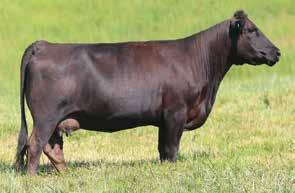







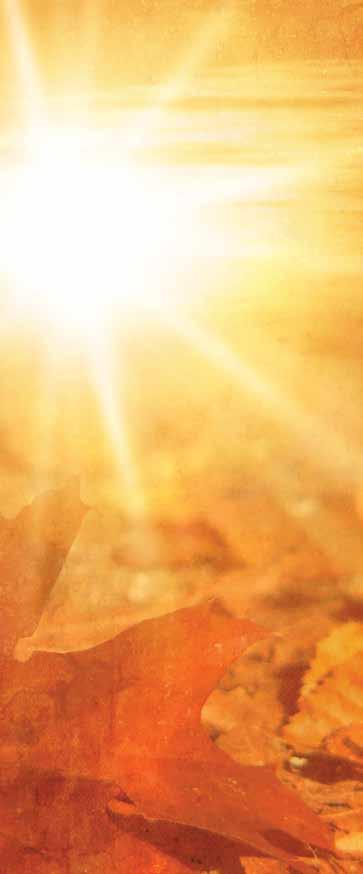







with other area landowners to grow seed under contract. In addition to native seeds, an average of 500 acres of soybeans and oats are grown each year.
Riders Mill Farms contains a cave that serves as a maternity site for 36,000 gray bats, a federally listed endangered species. The Seymours vigorously protect the cave, closing it to only biologists from April through October.
The Seymours have an agreement with Kentucky Department of Fish & Wildlife to provide public fishing access along a half mile of Roundstone Creek, which the agency stocks with trout. They also host long-term studies of reptiles and amphibians in collaboration with conservation organizations and universities.
More than 100 acres have been restored as oak savanna at the farm, which has served as a release site with habitat for ruffed grouse. The Seymours also partnered with neighbors to provide a 5,000-acre protection zone for turkey.
In 2024, they hosted an event with the University of Kentucky that attracted more than 100 forestland owners interested in conservation. It’s proof that their willingness to share innovative native plant propagation methods has spread the Seymours land ethic far beyond their remote, but rejuvenated piece of Hart County. Accolades
“The Kentucky Agricultural Council is proud to once again partner in recognizing exceptional stewardship and conservation work as demonstrated by the Seymour family,” said Tod Griffin, Kentucky Agricultural Council’s chair. “The winner of the 2025 Leopold Conservation Award represents lifelong work to promote good stewardship in their farming operation and also through their agribusinesses, Roundstone Native Seed Company, that works to spread that stewardship nationwide.”
“Kentucky’s 121 conservation districts promote the sound management of all our natural resources, and we are
excited to join in recognizing the well-deserving Seymour family,” said Allan Bryant, Kentucky Association of Conservation Districts president. “This year’s Kentucky Leopold Conservation Award recipient is truly a working family farm and native seed business with a strong land stewardship ethic.”
“These award recipients are examples of how Aldo Leopold’s land ethic is alive and well today,” said Kevin McAleese, Sand County Foundation president and CEO. “Their dedication to conservation is both an inspiration to their peers as well as a reminder to all how important thoughtful agriculture is to clean water, healthy soil and wildlife habitat.”
“As the national sponsor for Sand County Foundation’s Leopold Conservation Award, American Farmland Trust celebrates the hard work and dedication of the award recipients,” said John Piotti, AFT president and CEO. “At AFT we believe that exemplary conservation involves the land itself, the practices employed on the land, and the people
who steward it. This award recognizes the integral role of all three.”
The Kentucky Leopold Conservation Award is made possible thanks to the generous support and partnership of American Farmland Trust, Kentucky Agricultural Council, Kentucky Association of Conservation Districts, Sand County Foundation, Kentucky Farm Bureau Federation, U.S Department of Agriculture’s Natural Resources Conservation Service, AgriBusiness Association of Kentucky, Farm Credit Mid-America, Kentucky Cattlemen’s Association, Kentucky Corn Growers Association, Kentucky Department of Agriculture, Kentucky Department of Fish and Wildlife Resources, Kentucky Pork Producers, Kentucky Soybean Promotion Board, Kentucky Tree Farm Committee, Kentucky Woodland Owner’s Association, and the University of Kentucky College of Agriculture, Food and Environment.
For more information on the award, visit www.leopoldconservationaward. org.


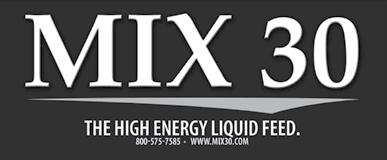

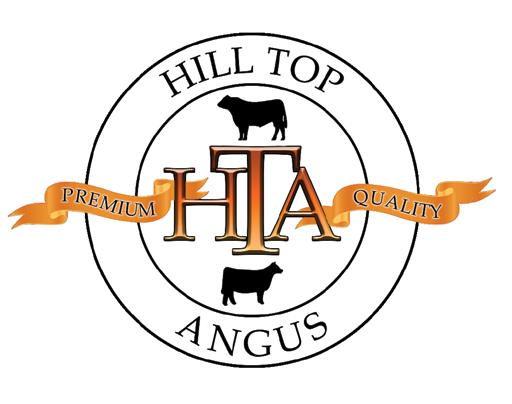





LEGISLATIVE UPDATE
NCBA NOTCHES LEGAL VICTORY PROTECTING CATTLE PRODUCERS FROM OVERREACHING EMISSIONS REGULATION
WASHINGTON (Aug. 11, 2025) –Last week, the National Cattlemen’s Beef Association (NCBA) notched a legal victory in the U.S. District Court for the District of Columbia affirming protections for cattle farmers and ranchers from onerous and unnecessary air emissions reporting requirements. NCBA, along with a coalition of other livestock and farm groups, has engaged in this litigation for years to ensure that family farmers and ranchers were not forced to file complex, overreaching reports with the federal government about emissions under the Emergency Planning and Community Right-to-Know Act (EPCRA) and Comprehensive Environmental Response, Compensation, and Liability Act (CERCLA).
“CERCLA and EPCRA were intended
to address the worst industrial and toxic chemicals, not govern family farms and ranches. This decision affirms that family cattle producers should not have to file reports for a natural, biological process under a law meant for significant chemical contaminants,” said NCBA Executive Director of Natural Resources Kaitlynn Glover. “NCBA stepped up to protect family farms and ranches through this litigation and we are pleased that the federal district court has brought clarity to this decadeslong discussion."
CERCLA and EPCRA are laws intended to address massive, severe chemical spills and environmental contaminants. Unfortunately, these laws have been weaponized by animal rights activists seeking to target family farms and ranches. The ruling in this case upholds a reporting exemption issued by the Environmental Protection Agency in 2019 that exempted cattle producers from reporting emissions under

EPCRA, an exemption that was affirmed through the 2018 Farm Bill.
NCBA ENDORSES
HELP ACT TO SUPPORT LIVESTOCK HAULERS
WASHINGTON (July 28, 2025)
– Today, the National Cattlemen’s Beef Association (NCBA) urged support for the Hauling Exemptions for Livestock Protection (HELP) Act introduced by Rep. Jeff Hurd (R-CO). This legislation supports livestock haulers by protecting drivers from burdensome hours of service (HOS) and electronic logging device (ELD) mandates.
“When you are hauling cattle, you are dealing with livestock that must be protected from the elements and cannot be easily unloaded until you get to your destination. Livestock haulers need flexibility to complete their trips free from government mandates,” said NCBA Policy Division Chair Skye Krebs, an Oregon rancher who hauls livestock and holds a Commercial Driver’s License. “During the COVID-19 pandemic, haulers and ranchers like me were granted additional flexibility on hours of service and electronic logging devices. In that time, we proved that we could safely transport our livestock and also support the overall supply chain."
The HELP Act codifies HOS and ELD exemptions that were issued by the Federal Motor Carrier Safety Administration (FMCSA) for about two years during the pandemic. Since then, America’s livestock haulers have been burdened by HOS rules again, but this legislation would reinstate permanent exemptions, providing the flexibility necessary to safely transport livestock.
Last week, FMCSA and the National Highway Traffic Safety Administration announced they are withdrawing a proposed rule to mandate speed limiters in trucks. This announcement was welcome news for livestock haulers, but HOS and ELD mandates continue to pose a threat to drivers. NCBA strongly supports the HELP Act and thanks Rep. Hurd for introducing it. We urge Congress to pass this legislation.
org *Savings total is an estimate based o of the Arrowlock 75 series standard base model with no accessories using the US Government section 179.org calculator. Final sacings total will vary depending on the individual and their personal 2024 tax return.

Equipment MUST BE purchased and used by DEC 31, 2025.


Class X Visits Colorado to Deepen Understanding of the Beef Industry
Rachel Cain Kentucky Cattlemen's Association
Class X of the Leadership Development Program recently completed its fifth session, deepening their understanding of the beef and agriculture industries beyond Kentucky.
The session began with participants traveling to Denver, Colorado, where they began with a visit to the National Cattlemen’s Beef Association. The group had discussions with several NCBA staff. Colin Woodall, KCBA
chief executive officer, discussed the mission and objectives of NCBA. Mandy Carr, senior executive director, Scientific Affairs, discussed the various ways that the Checkoff dollar is used to support promotion,


education, and research. CattleFax Analyst, Holden Ramey, discussed current trends and projections within the cattle market.
The group enjoyed a delicious lunch prepared by NCBA’s Culinary Team. The chefs discussed how they develop recipes, provide content and work with both consumers and industry professionals to promote beef.
Participants ended the day by catching a Colorado Rockies baseball game at Coors Field.
Day 2
Day two of this session began by traveling north to Greeley, Colorado, where many large agricultural operations are located.
The group began with an immersive tour of the JBS Processing Facility that is located in Greeley. This beef plant has the capacity to process 5,400 head/day. They then traveled to Five Rivers Feeding (Kuner Feedlot) and met with Mary Misgen, specialty beef program manager, for a tour of the feedyard and discussion. The group ended the day with a stop at Greeley Hat Works where owner, Trent Johnson, walked them through the hat making process and history of the business.
Day 3
Day three featured several industryfocused tours. The day began at
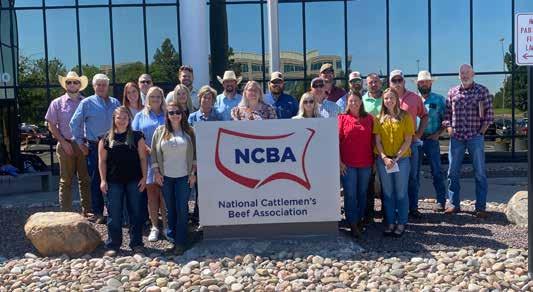
Empire Dairy in Wiggins, Colorado, where the Dinis family milks approximately 5,000 Holstein cows daily. Their milk is primarily used in mozzarella cheese production.
The group then visited Coyote Ridge Ranch in LaSalle, Colorado, a threegeneration Hereford cattle operation run by the Cornelius family. The family raises both commercial and seedstock bulls and females and hosted the class for lunch.
Afterward, the group traveled to Harper Feeders in Eaton, Colorado, a fourth-generation sheep feedlot with a 65,000-head one-time capacity. They are typically able to run 2.5 times the capacity through the operation annually. Participants engaged in discussions about the differences between feeding sheep
and cattle and toured the facility, which was designed by animal behaviorist Dr. Temple Grandin.
The final stop of the day was Hungenberg Produce in Greeley, which specializes in carrot production. The farm operates on approximately 4,000 acres and grows carrots, onion sets, pinto beans and shell corn. Their 100,000-square-foot processing facility supplies major retail customers.
Day 4
The trip concluded with sightseeing in the Rocky Mountains and a tour of Coors Brewery--the largest single-site brewery in the world.
Class X is funded through the Kentucky Cattlemen’s Foundation. Session six is scheduled for October 2025 in Washington, D.C.

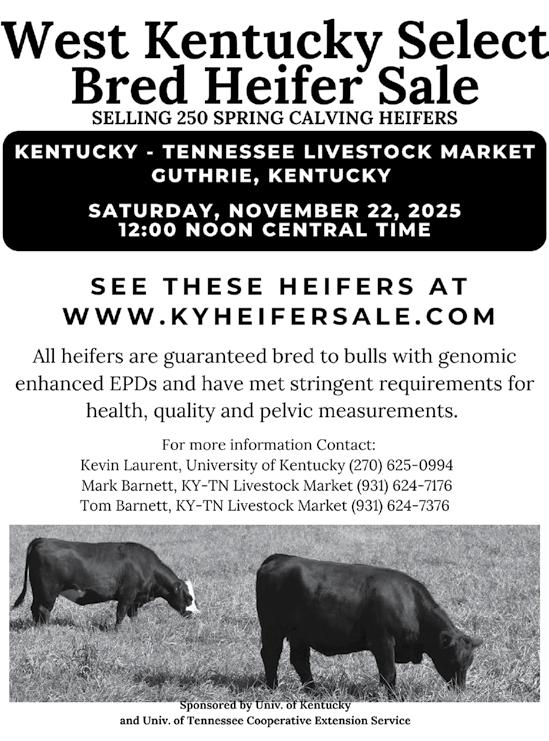
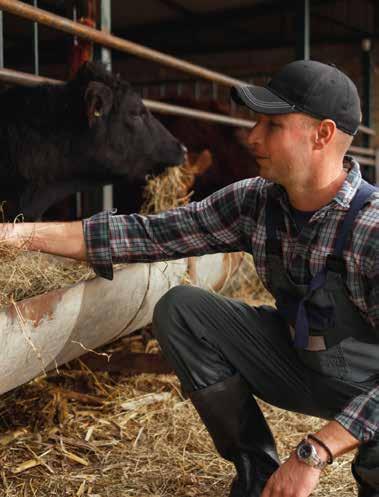
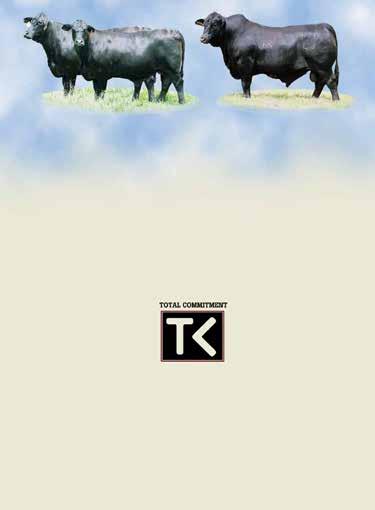
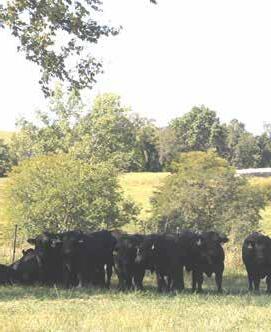


Herd Hangout Shows Success For KJCA
Jennie Watts KJCA Board Member, Trigg County
The Kentucky Junior Cattlemen’s Association board of directors recently had the opportunity to show members ages 7-14 the different aspects of KJCA, beef cattle and more at Blue Grass Stockyards. The day started off with fun cattle-themed icebreakers like four corners, this or that and bingo. Although, this wasn’t any ordinary bingo! The winners of each round had to give their best “moo” to claim a prize. Two of the board members, Matthew Estes and Landon Miller, also faced off against one another to see who could “moo” the best.
Once everyone was warmed up and ready for the day, the participants went on a tour of the stockyards and learned about the history of the building. After the tour, one group gathered in the YARDS classroom for a lesson on how to create a cow tag for "Brutus," KCA's fiberglass bull.
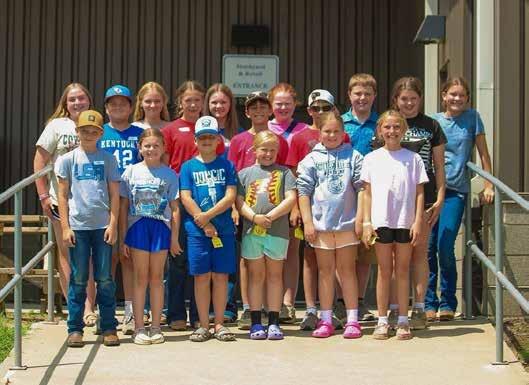
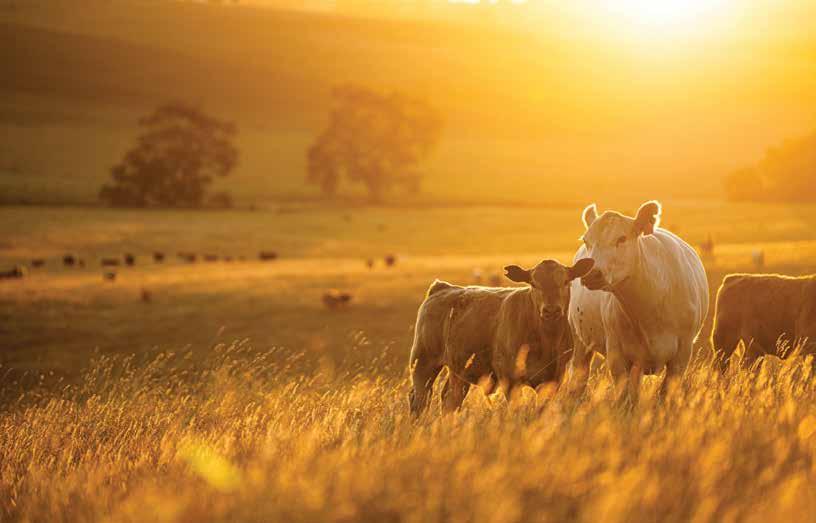

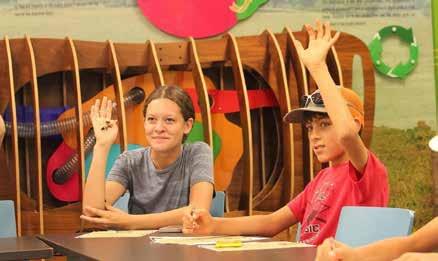

The other group learned how farmers must manage their money. This was through the “Cash Cow” activity, where the participants had to roll dice to determine if they can either add or subtract from their herd and money. Then, the person with the most money at the end was deemed the winner of the activity.
Once the groups had been through both activities, everyone came back to together for a lunch and learn, where the board members talked with participants about everything KJCA has to offer. The meal for the lunch, of course, was burgers!
Following lunch, the directors put on a scavenger hunt throughout the stockyards, which required participants to find directors who had certain clues. The clues included learning about cattle breeds, feed, byproducts, branding, farm-to-plate, expenses and more! The first team to complete the scavenger hunt was the winner.
The day ended with delicious ice cream and a competitive cornhole tournament! KJCA board members even went head-to-head with each other in their own intense competition.
All in all, there were around 17 attendees for the successful Herd Hangout event, not including the KJCA board members. For more information on the Kentucky Junior Cattlemen’s Association, visit kycattle.org/kjca. We hope to see you all at the KJCA Fall Classic Oct. 3-5 in Bowling Green!
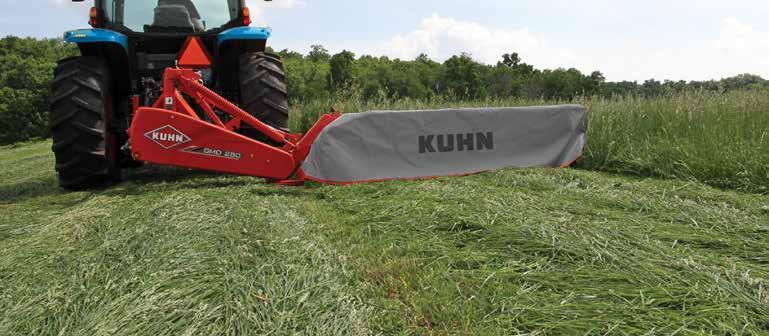
AND FORAGE TOOL SPECIALISTS






Mower Conditioners Tedders
(5 mg/mL doramectin, 150 mg/mL levamisole hydrochloride)
CAUTION: Federal law restricts this drug to use by or on the order of a licensed veterinarian.
INDICATIONS:
VALCOR™ is indicated for the treatment and control of the following species of parasites in beef cattle two months of age and older and in replacement dairy heifers less than 20 months of age. Not for use in beef bulls intended for breeding over 1 year of age, dairy calves, and veal calves.
ostertagi (including
lyrata, Haemonchus placei, Trichostrongylus axei, T. colubriformis, T. longispicularis*, Cooperia oncophora, C. pectinata*, C. punctata, C. surnabada, Bunostomum phlebotomum*, Strongyloides papillosus*, Oesophagostomum radiatum, Trichuris spp.*, Nematodirus helvetianus*. Lungworms (adults and
stage larvae): Dictyocaulus viviparus. Eyeworms (adults): Thelazia spp. Grubs (parasitic stages): Hypoderma bovis, H. lineatum. Sucking Lice: Haematopinus eurysternus, Linognathus vituli, Solenopotes capillatus. Mange Mites Psoroptes bovis, Sarcoptes scabiei. *Adults
cause staggering or paralysis. These reactions are not specific to treatment with VALCOR™ and can occur with any successful treatment of grubs. Cattle should be treated either before or after these stages of grub development. Consult your veterinarian concerning the proper time for treatment. Follow recommended dosage carefully. Reproductive safety has not been evaluated in bulls intended for breeding.
ADVERSE REACTIONS: This product is likely to cause swelling at the injection site. Tissue damage at the injection site may also occur, including possible granulomas and necrosis. These reactions have resolved without treatment. Local tissue reaction may result in trim loss of edible tissue at slaughter. A single death attributed to clostridial infection associated with the injection of VALCOR™ was reported in a nonpivotal effectiveness study. Observe cattle for injection site reactions. If injection site reactions are suspected, consult your veterinarian. This product is not for intravenous or intramuscular use. Hypersalivation may be observed; however, this reaction will disappear within a few hours. If this condition persists, a veterinarian should be consulted.
Gastrointestinal Roundworms (adults and fourth stage larvae): Ostertagia ostertagi (including inhibited larvae), O. lyrata, Haemonchus placei, Trichostrongylus axei, T. colubriformis, T. longispicularis*, Cooperia oncophora, C. pectinata*, C. punctata, C. surnabada, Bunostomum phlebotomum*, Strongyloides papillosus*, Oesophagostomum radiatum, Trichuris spp.*, Nematodirus helvetianus*. Lungworms (adults and fourth stage larvae): Dictyocaulus viviparus. Eyeworms (adults): Thelazia spp. Grubs (parasitic stages): Hypoderma bovis, H. lineatum. Sucking Lice: Haematopinus eurysternus, Linognathus vituli, Solenopotes capillatus. Mange Mites: Psoroptes bovis, Sarcoptes scabiei. *Adults only
WARNINGS AND PRECAUTIONS:
WITHDRAWAL PERIODS AND RESIDUE WARNINGS:
Contact Information: Contact Zoetis Inc. at 1-888-963-8471 or www.zoetis.com. To report suspected adverse drug experiences, contact Zoetis Inc. at 1-888-963-8471. For additional information about reporting adverse drug experiences for animal drugs, contact FDA at 1-888-FDA-VETS or http://www.fda.gov/reportanimalae. TARGET ANIMAL SAFETY: Margin of Safety: Subcutaneous administration of VALCOR™ was well tolerated in calves as young as 3 months of age at 1, 2, or 3 times the recommended dose. Dose-dependent post-dose hypersalivation was seen in all
Cattle must not be slaughtered for human consumption within 15 days following last treatment with this drug product. Not for use in female dairy cattle 20 months of age or older, including dry dairy cows; use in these cattle may cause drug residues in milk and/or in calves born to these cows or heifers. Not for use in beef calves less than 2 months of age, dairy calves, and veal calves. A withdrawal period has not been established for this product in pre-ruminating calves.
User Safety Warnings: Not for human use. Keep out of reach of children. If accidental eye contact occurs, flush eyes immediately with water for 15 minutes and seek medical attention. If wearing contact lenses, flush eyes immediately with water before removing lenses then continue rinsing for at least 15 minutes. Do not eat, drink or smoke while handling the product. Wash hands after use. Take care to avoid accidental selfinjection. If accidental injection occurs, seek medical attention and provide product package insert to medical professional. To obtain a Safety Data Sheet(s), contact Zoetis Inc. at 1-888-9638471 or www.zoetis.com.
Animal Safety Warnings and Precautions: Use of levamisole in cattle treated in the last few days with cholinesterase inhibitors such as organophosphates or with morantel may enhance the toxic effects of levamisole. Use together with caution.
Destruction of Hypoderma larvae (cattle grubs) at the period when these grubs are in vital areas may cause undesirable host-parasite reactions including the possibility of fatalities. Killing H. lineatum when it is in the tissue surrounding the gullet may cause bloat; killing H. bovis when it is in the vertebral canal may cause staggering or paralysis. These reactions are not specific to treatment with VALCOR™ and can occur with any successful treatment of grubs. Cattle should be treated either before or after these stages of grub development. Consult your veterinarian concerning the proper time for treatment. Follow recommended dosage carefully. Reproductive safety has not been evaluated in bulls intended for breeding.
ADVERSE REACTIONS: This product is likely to cause swelling at the injection site. Tissue damage at the injection site may also occur, including possible granulomas and necrosis. These reactions have resolved without treatment. Local tissue reaction may result in trim loss of edible tissue at slaughter. A single death attributed to clostridial infection associated with the injection of VALCOR™ was reported in a nonpivotal effectiveness study. Observe cattle for injection site reactions.
If injection site reactions are suspected, consult your veterinarian. This product is not for intravenous or intramuscular use. Hypersalivation may be observed; however, this reaction will disappear within a few hours. If this condition persists, a veterinarian should be consulted.
Contact Information: Contact Zoetis Inc. at 1-888-963-8471 or www.zoetis.com. To report suspected adverse drug experiences, contact Zoetis Inc. at 1-888-963-8471. For additional information about reporting adverse drug experiences for animal drugs, contact FDA at 1-888-FDA-VETS or http://www.fda.gov/reportanimalae.
TARGET ANIMAL SAFETY:
Margin of Safety: Subcutaneous administration of VALCOR™ was well tolerated in calves as young as 3 months of age at 1, 2, or 3 times the recommended dose. Dose-dependent post-dose hypersalivation was seen in all treated groups compared to the controls. All cases of hypersalivation were mild, transient, and resolved without further medical intervention. Dose-related injection site reactions were observed, and those in the 1X group resolved between 21 and 28 days post injection. Injection site reactions were primarily swelling which resolved between 21 and 28 days post injection. Findings from the injection sites included swelling, edema, inflammation, muscle necrosis and fibrosis.
up creative from here:\rafp://sentinel.hq.bader-rutter.com/Production/Zoetis/2024/ZOBF/PARA/ ZOBF4PARA054_Ad_Resizes/01_Assets/Valcor_3rd_Page_ Brief_Summary.pdf\r\rCenter to fit in size above.\r\rNew filename: Valcor_3rd_Page_Brief_Summary_CC
To
Sheet(s), contact Zoetis Inc. at 1-888-963-8471 or www.zoetis.com. Animal Safety Warnings and Precautions: Use of levamisole in cattle treated in the last few days with cholinesterase inhibitors such as organophosphates or with morantel may enhance the toxic effects of levamisole. Use together with caution. Destruction of Hypoderma larvae (cattle grubs) at the period when these grubs are in vital areas may cause undesirable host-parasite reactions including the possibility of fatalities. Killing H. lineatum when it is in the tissue surrounding the gullet may cause bloat; killing H. bovis when it is in the vertebral canal may cause staggering or paralysis. These reactions are not specific to treatment with VALCOR™ and can occur with any successful treatment of grubs. Cattle should be treated either before or after these stages of grub development. Consult your veterinarian concerning the proper time for treatment. Follow recommended dosage carefully. Reproductive safety has not been evaluated in bulls intended for breeding.


Register by September 30th, 2025
medical intervention. Dose-related injection site reactions were observed, and those in the 1X group resolved between 21 and 28 days post injection. Injection site reactions were primarily swelling which resolved between 21 and 28 days post injection. Findings from the injection sites included swelling, edema, inflammation, muscle necrosis and fibrosis.
Female Reproductive Safety: The reproductive safety of VALCOR™ was established in two studies with female cattle. First, a single dose of VALCOR™ was administered subcutaneously at 3 times the recommended dose at times coinciding with folliculogenesis, implantation, or organogenesis, and had no effects on conception, calving, abortion, and stillbirth rates, and post-natal viability up to 30±2 days post-calving. There were no congenital abnormalities. The only test article-related change was an increase in incidence and duration of swelling at injection sites compared with control, but all swellings eventually resolved. In a second study, a single dose of VALCOR™ administered subcutaneously at 3 times the recommended dose at either early or late gestation had no effects on calving, abortion, and stillbirth rates, and post-natal viability up to 30±2 days post-calving. One control calf and two treated calves were born with congenital abnormalities and did not survive. These were not determined to be test article-related. The only test article-related change was an increase in incidence and duration of swelling at injection sites, but all swellings eventually resolved. Not for use in bulls intended for breeding over 1 year of age, as reproductive safety has not been evaluated.
HOW SUPPLIED: VALCOR™ is available in
ADVERSE REACTIONS: This product is likely to cause swelling at the injection site. Tissue damage at the injection site may also occur, including possible granulomas and necrosis. These reactions have resolved without treatment. Local tissue reaction may result in trim loss of edible tissue at slaughter. A single death attributed to clostridial infection associated with the injection of VALCOR™ was reported in a nonpivotal effectiveness study. Observe cattle for injection site reactions. If injection site reactions are suspected, consult your veterinarian. This product is not for intravenous or intramuscular use. Hypersalivation may be observed; however, this reaction will disappear within a few hours. If this condition persists, a veterinarian should be consulted.
and
vials.
STORAGE, HANDLING, AND DISPOSAL: Store
Contact Information: Contact Zoetis Inc. at 1-888-963-8471 or www.zoetis.com. To report suspected adverse drug experiences, contact Zoetis Inc. at 1-888-963-8471. For additional information about reporting adverse drug experiences for animal drugs, contact FDA at 1-888-FDA-VETS or http://www.fda.gov/reportanimalae.
TARGET ANIMAL SAFETY: Margin of Safety: Subcutaneous
Female Reproductive Safety: The reproductive safety of VALCOR™ was established in two studies with female cattle. First, a single dose of VALCOR™ was administered subcutaneously at 3 times the recommended dose at times coinciding with folliculogenesis, implantation, or organogenesis, and had no effects on conception, calving, abortion, and stillbirth rates, and post-natal viability up to 30±2 days post-calving. There were no congenital abnormalities. The only test article-related change was an increase in incidence and duration of swelling at injection sites compared with control, but all swellings eventually resolved. In a second study, a single dose of VALCOR™ administered subcutaneously at 3 times the recommended dose at either early or late gestation had no effects on calving, abortion, and stillbirth rates, and post-natal viability up to 30±2 days post-calving. One control calf and two treated calves were born with congenital abnormalities and did not survive. These were not determined to be test article-related. The only test article-related change was an increase in incidence and duration of swelling at injection sites, but all swellings eventually resolved. Not for use in bulls intended for breeding over 1 year of age, as reproductive safety has not been evaluated.
HOW SUPPLIED:

resolved without further
TOUGH ON TOUGH WORMS, EASY ON CATTLE PRODUCERS.

You can achieve effective parasite control in one product, where before you may have needed two. Valcor® (doramectin and levamisole injection) is the first prescription cattle dewormer with two active ingredients in one dose. It’s never been easier to be tough. Get tough at ValcorTough.com.


















IMPORTANT SAFETY INFORMATION: Do not treat cattle with Valcor within 15 days of slaughter. Not for use in female dairy cattle 20 months of age or older, including dry dairy cows; not for use in beef calves less than 2 months of age, dairy calves, and veal calves. Safety has not been evaluated in breeding bulls. Use with caution in cattle treated with cholinesterase inhibitors. This product is likely to cause injection site swelling; tissue damage (including granulomas and necrosis) may occur. These reactions have resolved without treatment. See Brief Summary of Full Prescribing Information on the next page.


When you apply nitrogen and lime in September, cool-season grasses benefit, but so do weeds. Thistle, hemlock, ironweed, and other nutrient thieves are lying in wait, ready to rob your pasture of costly fertility inputs. Don’t let weeds steal your investment.
Alligraze is a new treatment method that allows land managers to combine residual herbicide with dry fertilizer, achieving broadleaf weed control and fertility in a single pass.
Gunslinger® AMP - for wide-spectrum control of tough weeds Prescott - a non-2,4-D option delivering outstanding performance
“Out of all the herbicides I have used on dry fertilizer, Prescott has been the best I have ever seen.”
- Paul Whiteside, Whiteside Farms, Hampshire, Tennessee
Protect your investment with Alligraze. Scan the QR code or visit ALLIGARE.COM.
Super 7 Ultra is an umbilical & navel dip that is more costeffective and proven to work faster than 7% iodine.
Ultra-fast umbilical dry-out solution
Dyed for rapid identification
Costs less than 7% Iodine & Triodine
Exempt from hazardous shipping & handling charges
Available in 55 gallon drum upon request
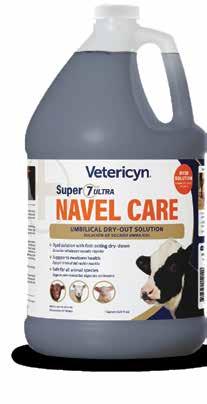
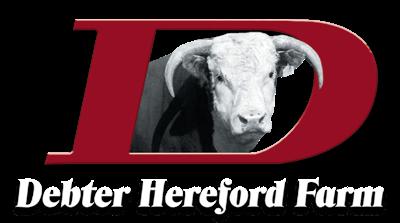



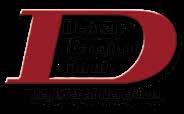
Young Ambition
Katie Pratt Kentucky Cattlemen's Association
PAINT LICK, KY− It’s business as usual on a late afternoon in August – the day before school starts in Madison County− and cattle producers Isaac and Amanda Marcum are at the end of a long, gravel road checking on their bred heifers. When they aren’t at their full-time, off-the-farm jobs, they can be found with their cattle at one of the two farms they rent on the south end of the county.
“We are at the farms most weekdays from 5 p.m. until dark and sometimes from 5 p.m. until we go back to work the next day. Then we are here all weekend,” Isaac Marcum said.
“We don’t have a generational farm or family close by that can help us with the cattle,” Amanda Marcum said. “So, if something needs to get done on the farm, we are the ones who have to do it.”
The Marcum’s background around 250 steers from fall through late summer and also raise 40 bred heifers each year. They manage their herds while juggling the demands from their other jobs. He is an insurance agent with Kentucky Farm Bureau, and she is a second-grade teacher for Madison County Schools.
“They are progressive producers,” said Brandon Sears, Madison County’s agriculture and natural resources extension agent. “They look at new options and are willing to try new things when it fits their system.”
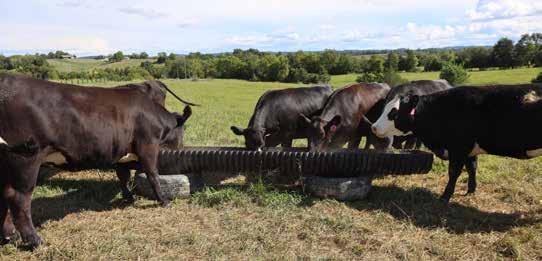
Shared Love of Ag
The Marcum’s met at W&W Veterinary Services in Richmond. At the time, Amanda had aspirations of going to veterinary school and was working at the clinic as a vet tech, and Isaac was a client. Both have strong ag backgrounds. Ray Marcum, Isaac’s father, was a farm manager in charge of the Eastern Kentucky University beef herd for over 33 years before he retired. Amanda grew up on a horse farm in neighboring Clark County but learned a lot about cattle by accompanying Veterinarian Dr. Nick
Werle, as he made farm visits and worked cattle at Paris Stockyards. Both are EKU alumni –he has a degree in agribusiness, and she has degree in elementary education.
Development Pressure
Like many young producers, the Marcum’s find themselves renting land as they build their operation and equity. Isaac began renting farms for cattle production in 2017. Amanda joined the operation soon after. They currently rent two adjoining farms for a total of 470 acres.
CONTINUED ON PAGE 32
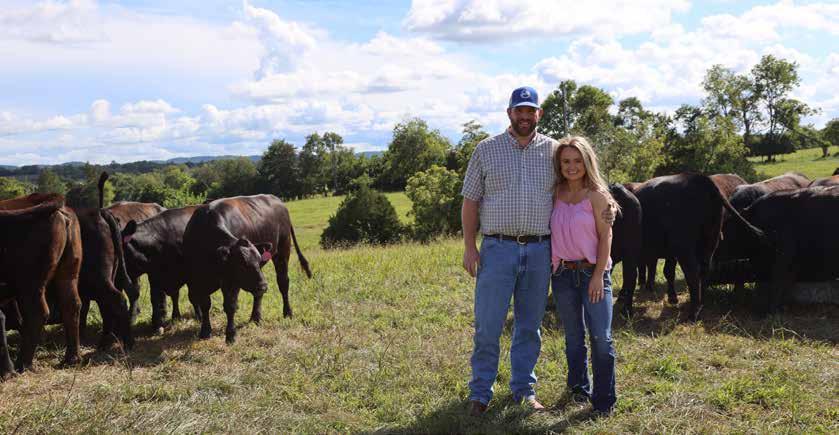
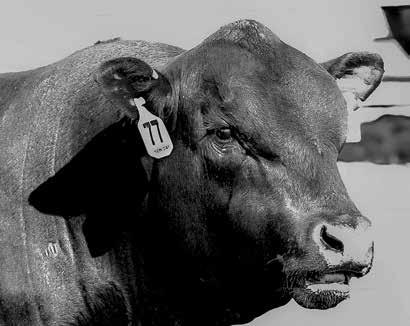
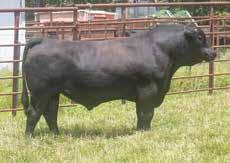


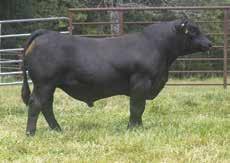























“There is not a lot of farmland that comes up for sale in Madison County, and when it does, it is priced for development,” he said. “Cattle operators can’t compete with developers. Producers almost have to find a landowner who wants to sell their land and keep it in agriculture to get a price that’s affordable.”
Like many areas of Central Kentucky, Madison County and its county seat, Richmond, are facing immense growth pressure. According to 2024 estimates from the U.S. Census Bureau, Richmond is the second fastest growing city in the state grew 2.8% in population from 2023 to 2024. Madison County is home to Eastern Kentucky University and Berea College. The Madison County website lists the county’s economic development opportunities and strong manufacturing, education, agriculture and technology sectors.
“I admire their perseverance,” Sears said. “There are many barriers to entry for beginning farmers, and it’s challenging to purchase agricultural land given how much its price has increased over the years. Its also quite expensive to purchase cattle right now, especially when starting a herd from scratch. A lot of local producers look to the Marcum’s for advice on what has worked for their operation. It’s nice when farmers can learn from each other and especially good to see them succeed.”
Renting land affects the Marcum’s management practices. They use electric fencing and rotationally graze their animals. They partner with another producer to cut hay on their farms and split the hay rolls.
“You can’t justify putting in fences and water sources on rented land, so we have to find ways to maximize our forage production with minimal costs,” Isaac Marcum said.
Steer Production
Isaac Marcum began his cattle operation as a backgrounder. From 2017-2020, he sold one load of steers each year. He increased his herd after he began renting one of his current farms. He and Amanda typically purchase steers in the fall and sell

them in the late summer.
“During the winter, we feed them a mix of feed and hay with the goal not necessarily of adding pounds but growing their frame,” he said. “We really want them to be in a condition to where they quickly gain weight when the grass comes on in the spring.”
Today, they sell the steers at the stockyards and through private treaties. They sold the steers earlier than they normally would this year because of the high cattle prices.
Raising that many steers carry high risks, especially with market swings. The Marcum’s are big proponents of Livestock Risk Protection Insurance. Isaac Marcum has taken out the insurance since 2017 and began selling it through Farm Bureau a few years ago.
“Isaac has been really good at educating, particularly new producers, on the benefits of LRP insurance,” Sears said.
Intro
into Bred Heifers
While they do cut hay, they also purchase quite a bit. Two years ago, the Marcum’s decided to take one of their fields out of hay production and use it to raise bred heifers. The first
year, they raised and bred 20 heifers. Those sold in two days after Isaac advertised them on his Facebook account. The next year, they took a similar field at the other farm out of production to raise additional 20. All have already sold this year through Facebook and by word of mouth.
The Marcum’s are very consumer oriented so when they go to purchase heifers in December, they look for traits their customers want −black hided, big framed and docile.
“They have to be gentle because it’s just us out here feeding and caring for them,” Amanda Marcum said. “To get them used to me, I walk around them while we feed them.”
The heifers are bred to registered Angus bulls. The past two years, they bred the heifers on May 9, which put their calving date around Valentine’s Day.
For the Marcum’s, it’s not just about running a successful operation but they want to raise quality cattle that fit their customer’s needs.
“In this business, reputation is everything,” Isaac Marcum said. “You don’t want someone coming back to you unhappy about an animal you sold them.”



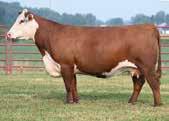



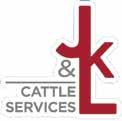



Frequently Asked Questions about Harmful Algal Blooms (HABs) in Farm Ponds Used to Water Livestock
Michelle Arnold DVM (Ruminant Extension Veterinarian, UKVDL)
Water is the most essential nutrient in the diet of cattle, and during hot and dry weather, it is especially important to monitor water quality if using farm ponds for livestock.
What is a “harmful algae bloom” or “HAB”? During periods of hot and dry weather, rapid growth of algae to extreme numbers may result in a “bloom,” which is a build-up of algae that creates a green, blue-green, white, orange or brown coloring on the surface of the water, like a floating layer of paint (see Figure 1). Blooms are designated “harmful” because some algal species release toxins (poisons) when stressed or when they die. The majority of HABs are caused by blue-green algae, a type of bacteria called “cyanobacteria” that exist naturally in water and wet environments. These microorganisms prefer warm, stagnant, nutrientrich water and are found most often in ponds, lakes and slow-moving creeks. Farm ponds contaminated with fertilizer run-off, septic tank overflow or direct manure and urine contamination are prime places for algae to thrive. Although blooms can occur at any time of year, they happen most often in hot, sunny weather with little wind and little recent rainfall, typically between June and September when temperatures reach 75 degrees or higher and ponds begin to stagnate. HABs can reduce water quality and intake, but more importantly, they can be deadly when ingested by livestock. Windy conditions can push algal blooms along water edges, increasing the risk for livestock to ingest algae when they drink.
Are all algal blooms poisonous to cattle? Of the more than 2,000 species of blue-green algae identified, at least 80 are known to produce toxins that can affect animals and humans (see Table 1). Blue-green algae toxins are released when algal
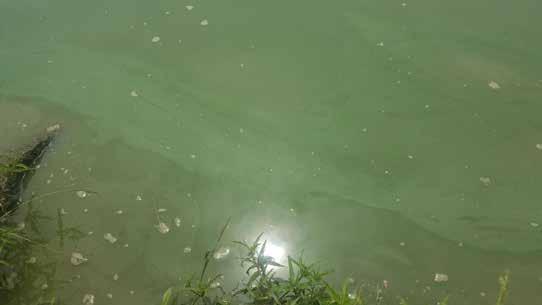

Table 1: A Water Utility Manager’s Guide to Cyanotoxins. Accessed 8/5/2025 at https://www.epa.gov/sites/ production/files/2016-06/documents/water-utility-managers-guide-cyanotoxins.pdf
cells are damaged and die in the water (for example, after water is treated with an algaecide such as copper sulfate), or when ingested water reaches the animal’s digestive tract and algal cells are disrupted, releasing
the toxins. The most common genera of blue-green algae in North America associated with livestock poisoning are Anabaena (also known as Dolichospermum), Aphanizomenon,
Figure 1: Pond in Scott County-Photo courtesy of Dr. Michelle Arnold, University of Kentucky

Figure 2: From The Indiana Department of Environmental Management website, accessed 8/5/2025 at https://www.in.gov/idem/algae/
Oscillatoria, and Microcystis. Microcystis is the most common bloom-forming genus, and blooms are typically a greenish, thick, paintlike (sometimes granular) material that accumulates along shores. If an algal bloom is observed, testing water samples is recommended to confirm it is blue-green algae. Be aware that having an algae bloom present in a pond does not automatically mean toxins are being produced but it is best to assume the water could be deadly if used for livestock drinking water. What are the most common signs of poisoning in cattle from bluegreen algae? Livestock are most at risk when drinking contaminated water or licking algae from their hair coat. Cyanobacterial toxins (“cyanotoxins”) primarily target the liver or nervous system and have been implicated in both human and animal illnesses and deaths worldwide. Some algae produce potent neurotoxins (toxins affecting the nervous system), most often the toxin Anatoxin-A, that may cause cattle to exhibit muscle tremors, difficulty breathing, wobbly gait, seizures, profuse slobbering, diarrhea and rapid death within minutes to hours. Others produce hepatotoxins (toxins affecting the liver), most commonly the microcystin toxin, that can cause sudden death or a more delayed onset of death after signs of liver failure develop such as lethargy, diarrhea and weakness. Cattle that survive the acute stages of liver damage may develop photosensitization, a skin condition in which white (light or non-pigmented) areas of skin along the back, face, udder, muzzle, underside of tongue, eyelids and ears will become red and swollen then will become crusty and peel. The only treatment for exposure to any cyanotoxin is supportive care and medications to help alleviate the symptoms.
Are humans affected by these toxins, too? Human poisoning associated with cyanotoxins most commonly occur after exposure through drinking contaminated water or after participating in water recreational activities. Exposure can result in a number of symptoms in
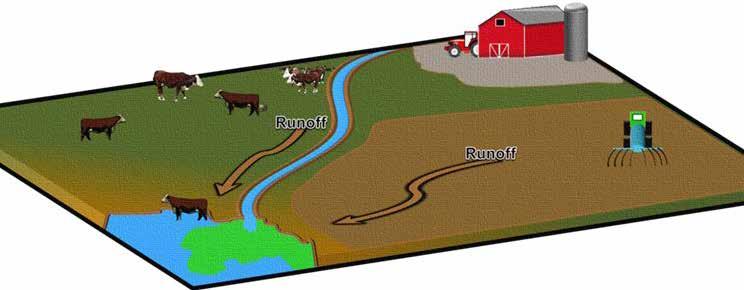
people including skin rashes; eye, nose, mouth or throat irritation; allergic reactions; headache and malaise; and gastrointestinal upset including abdominal pain, nausea, vomiting and diarrhea. In humans, it is believed the toxin must be ingested for fatalities to occur. For protection of human health from exposure to the algae and any of the toxins, many states use the World Health Organization guideline level of 100,000 algal cells/ml water or a microcystin toxin level of 6 parts per billion (ppb) for a Recreation Advisory and beaches will be closed if the microcystin toxin level reaches 20 ppb. For more information regarding human drinking water, visit the EPA website to view “A Water Utility Manager’s Guide to Cyanotoxins” at https://tinyurl.com/bsvx7vey.
How do I test water for bluegreen algae toxins? Unfortunately, testing water for the actual toxin is problematic because toxins are not uniformly distributed in the water source, toxin testing can be quite expensive, and there are many blue-green algae toxins for which no diagnostic tests exist. The Kansas State Veterinary Diagnostic Laboratory accepts water samples for blue-green algae identification by microscopy and, if positive, the lab can do further testing for cyanotoxin concentration. When sampling water, make sure to wear gloves and collect at least 500 mls (16 ounces) of water approximately one inch below the water surface. Samples should
be refrigerated before and during shipping but do not freeze. Please visit https://tinyurl.com/4ma272s3 for further information regarding sampling and shipping guidelines.
The Indiana Department of Environmental Management maintains an excellent website on all things associated with blue-green algae at https://www.in.gov/idem/ algae/. A very useful tool is the description of the “Jar and Stick” tests a pond owner can do to quickly assess the likelihood of blue-green algae in the water. A quick guide is also available to compare the appearance of non-toxic algae and plants from potentially toxic cyanobacteria blooms (Figure 2). Additional field images are available at the US Geological Survey website for cyanobacteria identification: https://pubs.usgs.gov/ of/2015/1164/ofr20151164.pdf.
Remember that field tests and observations are not 100% accurate so follow-up testing is recommended to definitively determine what algae species are present.
How do I prevent poisoning from blue-green algae?
For livestock and pets:
1. Always assume that a blue-green algal bloom is toxic.
2. Provide constant access to clean, clear fresh water and fence off or otherwise prevent access to stagnant, scum-covered ponds. Fencing off surface water sources and providing alternative clean
Figure 3: Cattle contribute excess nutrients to surface water by urinating and defecating in or around ponds and streams. Excess nutrients can also enter waterways as runoff from fertilized fields or manure laden pastures. Figure by Donnie Stamper, Biosystems and Agriculture Engineering, University of Kentucky
water sources is the best option for healthy cattle for many reasons, not just HABs.
3. Do not allow animals to contaminate the water with feces and urine. Prevent fertilizer or manure runoff from entering water sources. Phosphorous is particularly important in fueling cyanobacteria growth (see Figure 3).
4. If a water source is treated with an algaecide such as copper sulfate, prevent animal access to the water for at least two weeks or longer to allow degradation of any released toxins in the water. It is best to wait until the pond is no longer stagnant and test the water before allowing animals to drink from it.
5. Creating and maintaining natural buffers such as grass strips, trees and shrubs between farmland, housing developments and waterways can help filter out excess nitrogen and phosphorus before they reach the water.
6. A short-term solution to prevent algae blooms is installing solarpowered aerators to keep water moving and mixing.
Humans:
7. Do not swim or allow children or pets to swim in water with scum layers or blooms. Avoid jet-skiing, windsurfing, tubing or waterskiing over scum or blooms.
8. Do not use untreated water for drinking, cleaning food or washing camping gear.
9. Do not boil water to remove bluegreen algae; this will not remove algal toxins.
10. If you come into contact with a bloom, wash your skin and hair thoroughly. If your pet comes into contact with a bloom, wash it thoroughly with clean water to prevent blue-green algae ingestion when your animal licks itself.
11. Do not eat fish or shellfish caught or harvested in a bloom area.
12. Respect any water body closures by public health authorities.







Reducing Hay Feeding…Stockpiling and Winter Annuals
Chris Teutsch UK Research and Education Center, Princeton
Hay is an important part of ruminant livestock systems in transition zone states like Kentucky. However, it tends to be an expensive feed source compared to allowing animals graze during the winter months. The cost of producing a ton of grass hay can vary, but if you count fertilizer, machinery and a little labor, it will exceed $100. The other challenge is producing hay that is high enough in forage quality to meet the nutritional needs of lactating brood cows. This is especially important in a year like this one when frequent rainfall in the spring delayed first cutting in most parts of the state. On top of this, feeding that hay during the cold, wet and muddy winter months is not fun, especially if you have an off-the-farm job!
In contrast to hay, allowing animals to graze during the winter months can significantly reduce winter feed costs. In general, hay feeding is negatively correlated with profitability in ruminant livestock operations. There are two primary options for extending grazing into the winter months, stockpiling perennial forages like tall fescue or planting winter annual forages like small grains and annual ryegrass. The remainder of this article will discuss these options.
The Dollars and Sense of Extended Grazing
I want to start this section with the following disclaimer: I am a forage agronomist NOT an economist. Even if you are not an economist, thinking about costs in ruminant livestock production systems is important. Although cattle prices are good right now, they will come down at some point. This is when the difference between being profitable and losing money is the most strongly correlated to winter feeding programs. The following calculations are meant to provide you with a relative comparison of hay feeding versus grazing stockpiled grass. Calculations and considerations can vary
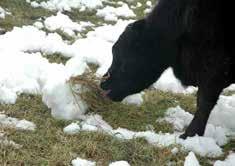
considerably from farm to farm. So, it is important that you use information and costs that are appropriate for your farm.
Cost of Feeding Hay Assumptions:
• Total cost of hay feeding is $120/ ton (hay cost + feeding cost = total cost)
• Hay cost is $100/ton (cost of producing your own hay, may be able to buy for less)
• Cost of feeding the hay is $20/ ton (labor, fuel, machinery, hay rings, etc.)
• Storage and feeding losses are 20% (could be much higher)
• Cows will eat 30 lbs. hay/day/cow
• In MOST cases, hay will need to be supplemented to meet the nutrient needs of a lactating cow. This cost will vary. A cost of $0.75/day/cow will be used in this example.
Feeding days per ton hay = (2,000 lbs./ton of hay - feeding losses in lbs./ ton of hay) / 30 lbs. hay/day/cow = (2,000 lbs./ton - 400 lbs./ton) / 30 lbs. hay/day/cow = 53 feeding days/ ton hay
Total cost of feeding hay = (Hay total hay costs per ton / feeding days per ton) + supplement cost per cow per day = ($120/ton hay / 53 days) + $0.75/day/cow = $3/day/cow
Cost of Stockpiling Assumptions:
• Stockpile yield of 2,500 lbs. DM/A
• Cost to stockpile tall fescue of $60/A
• 60 lbs. N/A + application cost about $40/A
• $20/A feeding cost (temporary fencing and labor to move fence)
• Utilization rate of 70% (strip grazing moving fence twice per week)
Grazing days per acre = (stockpile yield in lbs. DM/A x utilization rate in % / dry matter intake in lbs. DM/ day/cow = (2,500 lbs. DM/A x 70% utilization) / 27 lbs. DM/day/cow = 65 grazing days/A
Cost per grazing day = $60/A / 65 grazing days/A = $0.92/grazing day
Note: Since stockpiled tall fescue is higher in nutritional value than most hay made in Kentucky, supplementation is not normally needed.
The point of these calculations is NOT that they are the gospel truth, but rather to illustrate that grazing during the winter months will cost about one-third to one-half as much compared to hay feeding. In addition, hay feeding will likely require some supplementation.
Stockpiling Perennial Grasses
Stockpiling is simply allowing forage growth to accumulate during one part of the year and using that growth for deferred grazing at a later date. In transition zone states like Kentucky, cool-season pasture growth is commonly stockpiled in late summer to extend grazing during the winter months. Although most cool-season grasses can be stockpiled, tall fescue is by far the best adapted grass for stockpiling. Tall fescue stockpiled for winter grazing is almost always
Brood cow grazing stockpiled tall fescue in February.
higher in nutritional value than most of the hay that we make in Kentucky and will, in most cases, meet the requirements of a fall-calving cow during peak lactation. The following steps will help to optimize your stockpiling program.
Choose a strong tall fescue sod in a field that is well drained. To get the maximum yield response to nitrogen applications you will need a healthy stand of tall fescue. Choosing a field that is well-drained will help to ensure that the stockpile can be grazed with minimal pugging damage during the wet winter months.
Clip pastures that will be stockpiled to 3-4 inches prior to applying nitrogen. Clipping pastures removes old growth and increases the forage quality of the stockpiled grass.
Apply 60-80 lbs. of nitrogen per acre in mid-August to early-September. Applying nitrogen too early can stimulate warm-season grass growth in pastures, while applying nitrogen too late decreases dry matter yield. When applying nitrogen in early to mid-September, decrease application rates to 60 lbs./A.
Allow growth to accumulate until midDecember before grazing. If limited grazing is available, feed hay during late summer and fall to allow pastures to stockpile.
Graze stockpiled pastures that contain legumes first. Legumes deteriorate at faster rate than grass and should be grazed first to minimize losses.
Strip graze tall fescue to maximize grazing days. Ideally, allocating only enough stockpiled grass for two to three days will increase grazing days per acre by 30 to 40%. However, if you work off the farm, it may make more sense to allocate seven days of grass. This would allow you move fences on your days off.
Frost seed legumes on grazed areas. Closely grazed stockpile provides an excellent opportunity to establish legumes in grass-dominated pastures. Broadcasting the seed as the pasture is being grazed can enhance soil-seed contact and increase overseeding success.
FEATURED UPCOMING EVENT
2025 Intermediate Grazing School Versailles, KY • Sept. 24-25
For a more information visit https://forages.ca.uky.edu/events or contact your local extension office.
FEATURED PUBLICATION
Extending grazing and reducing stored feed needs by Don Ball, Ed Ballard, Mark Kennedy, Garry Lacefield, and Dan Undersander. You can access it at https://tinyurl.com/2n9wb5f9 or by visiting your local extension office.
FEATURED VIDEO
This month’s featured video is: “Seven things that I have learned about profitable ranching over the last 45 years” by Jim Gerrish. You can access it by visiting the KYForages YouTube Channel.
FORAGE MANAGEMENT TIPS
• Soil sample and apply any needed lime and fertilizer.
• Plant annual and perennial cool-season grasses and legumes. Consider incorporating novel endophyte tall fescue into your grazing system.
• Harvest late summer hay as needed. Do not harvest alfalfa after mid-September.
• Do NOT overgraze perennial pastures in late summer and fall. Pasture plants accumulate energy reserves in the fall that are used to overwinter and regrow in the spring.
• Feed hay and allow cool-season pastures to stockpile for winter grazing.
• Rest native warm-season pastures until after frost to enhance winter survival and subsequent productivity.

Strip grazing stockpiled tall fescue improves utilization rates and increases grazing days per acre.
Cool-Season Annual Grasses
Cool-season annual forages that can be used for winter and early spring grazing include small grains and annual ryegrass. Crimson clover, an annual clover, can be grown in a mixture with both the small grains and annual ryegrass. In general, the most profitable grazing systems will be based on well adapted perennial forages that are supplemented with summer and winter annuals. Annuals will almost always be a more expensive option than stockpiling well adapted perennial forages.
Winter Annual Options
Wheat is one of the most versatile small grains for a farming operation. Due to its excellent winter hardiness, wheat can be sown later in the fall than barley and has good potential for pasture, silage or hay production. Wheat will withstand wetter soils than barley or oats but tends to be less tolerant of poorly drained soils than rye and triticale. Managed properly, wheat can be grazed in the fall, again in early spring, and finally harvested for grain, hay or silage.
Barley is generally more susceptible to winterkill than wheat, especially when it has been overgrazed. It should not be grazed as short or as late into the fall as wheat. Barley does best on fertile, well-drained soils. It is sensitive to acidic soil conditions and poor fertility. Barley produces high quality silage or hay with a higher digestibility than other small grains, but lower yields. Good quality grazing can be obtained from early seeded barley.
Triticale is a high yielding forage crop that is gaining popularity. Triticale generally has a higher forage yield, but lower quality than wheat. It is a cross between rye and wheat. As such, it is adapted to a wide range of soils. Tolerance to low pH is better than wheat but not as good as rye.
Rye is the most cold tolerant and least exacting in its soil and moisture requirements of all small grains. Like wheat, rye can be sown in late August to provide fall grazing, excellent winter ground cover and
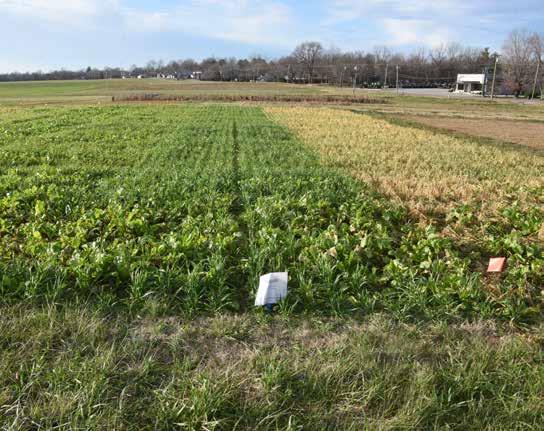
spring grazing. The rapid growth of rye, both in the fall and spring, makes it the most productive of the small grains for pasture. Rye is also the earliest maturing of the small grains. Rye tends to be a more consistent producer of spring pasture than wheat, although it quickly becomes stemmy and unpalatable in late spring.
Winter oats produce very palatable forage and are best adapted to welldrained soils. They do not perform as well under extremely dry or wet conditions as wheat or rye. Although oats produce high quality forage, yields tend to be lower than the other small grains. As a rule, the hardiest winter oat variety (Kenoat) is considerably less winter hardy than common wheat and barley varieties. In Kentucky, oats will usually overwinter 50% of the time. Similar to barley, winter oats must be seeded in mid-September to be well established before cold weather arrives.
Annual ryegrass is a cool-season annual that can provide late fall, winter and early spring grazing. Attributes of annual ryegrass include ease of establishment, high
yields, high nutritive value and later maturing than the small grains. In contrast to small grains, annual ryegrass continues to regrow in the spring until high temperatures limit growth in early summer. Annual ryegrass is commonly used to overseed summer pastures, thereby extending the useful season of this land area. It is adapted to all soil types and grows best at a pH of 5.7 or higher. The highest yields are obtained on fertile and well-drained soils with nitrogen fertilization.
Optimizing Cool-Season Annual Use
While winter annuals can provide ample and high quality forage in late fall, winter and early spring, they tend to be a more expensive option than stockpiling perennial grasses for winter grazing. However, they can fill certain niches within grazing systems. For example, they could be used to thicken thin cool-season pastures, grown in a rotation with a summer annual forage, used to overseed a warm-season perennial forages such as bermudagrass, or used in a renovation sequence. The following tips will help you optimize cool-season
Plots from the 2024 Winter Feeding Field Day held at UK Research and Education Center in Princeton. Spring oats (right) produced quick growth in late summer and fall but were damaged by low temperatures during the winter months.
annual use in your grazing system.
Planting date. Cool-season annuals can be seeded from mid-August to mid-October. If fall grazing is desired, plant by early September. Later plantings will provide little grazing in the fall and winter. Suppress existing sod. Suppressing competition from an existing sod or summer annual crop will help to ensure that you get a dense and uniform stand. Ideally pastures to be overseeded should be grazed closely and sprayed with a nonselective herbicide just prior to planting. Seeding directly into a healthy pasture stand that has not been suppressed normally results in a poor stands that are not productive.
Planting method. Winter annuals can be planted on a conventional
seedbed or no-till seeded. No-till seedings tend to support winter grazing better than conventional seedings.
Seeding depth. Seeding depth should be 1-2 inches for small grains and 0.5 to 1 inch for annual ryegrass.
Seeding rates. Small grains seeded alone should be planted at a rate of 90-150 lbs./A. Annual ryegrass seeded alone should be planted at a rate of 25 lbs./A. A mixture of small grain and annual ryegrass should be seeded at a rate of 90 and 15 lbs./A, respectively. If fall grazing is desired, use the higher end of the seeding rates. Crimson clover can be added at a rate of 10 lbs./A.
Soil fertility. Apply phosphorus, potassium and lime according
to soil test results. If fall grazing is desired, apply 40-60 lbs. nitrogen/A at seeding. An additional 40-50 lbs. nitrogen/A should be applied in early-March to stimulate spring growth. For annual ryegrass only, an additional 40-50 lbs. nitrogen can be applied in mid-April after the first grazing.
Grazing management. Ideally, winter annuals should be rotationally stocked. Grazing can begin once the seedlings are well anchored and have reached a height of 8-10 inches. Grazing should be stopped when a residual height of 3-4 inches has been reached.
For more information on stockpiling and winter grazing, please contact your local Cooperative Extension office or visit the UK Forages Webpage at https://forages.ca.uky.edu/.
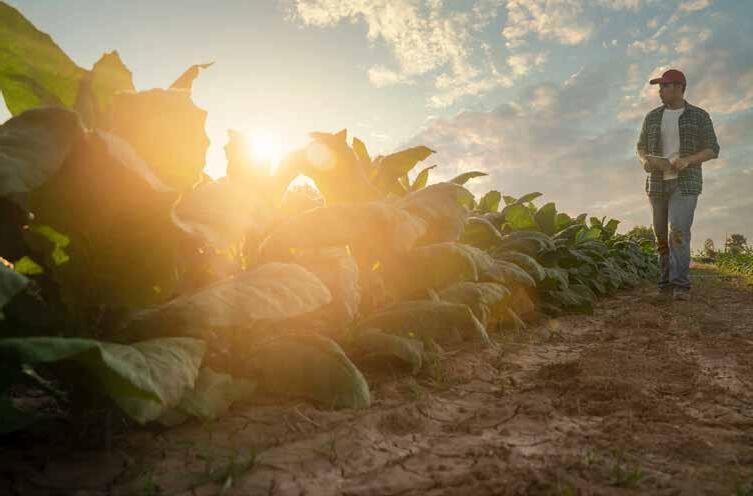


UK to Host September Grazing, Fencing Schools
Livestock producers can take advantage of educational opportunities offered by the University of Kentucky during September.
The first is an Intermediate Grazing School. It is Sept. 24-25 at the Woodford County Extension office in Versailles.
The school promises an immersive learning experience for livestock producers.
Topics on the first day include introduction to soils, rotational grazing, meeting nutritional needs on pasture, grazing math concepts, travel to a local grazing operation, portable/ seasonal water systems, methods to access pasture production and determine stocking rate, and hands-on small paddock set-up demonstrations.
Topics on the second day include fence types and costs, a grazing system
design case study and exercise, grazing myths that impact profitability and a discussion on how to reinvigorate a run-down farm.
Registration costs $60 per participant and ends Sept. 20. To register and purchase online, visit 2025IntermediateGrazing.eventbrite.com
For more information, contact Caroline Roper at 270-704-6618 or Caroline.Roper@uky.edu.
Another educational offerings include Fencing Schools that will be held in two different locations on Sept. 30 and Oct. 2.
The schools are designed for producers and agricultural professionals to learn the newest fencing methods and sound fencing construction through a combination of classroom and hands-on learning. These events include fencing types and
cost, fence construction basics, electric fencing basics, innovations in fencing technologies, Kentucky fencing laws and hands-on fence building! Catered lunch is included; registration costs $35 per participant. Cost includes a notebook, refreshments, safety glasses and hearing protection.
The Sept. 30 Fencing School is located at Hardin County Extension office: 111 Opportunity Way in Elizabethtown.
The Oct. 2 Fencing School is located at Russell County Extension office: 2688 S. HWY 127 in Russell Springs.
To register and purchase online, visit: FallFencingElizabethtown.eventbrite.com FallFencingRussellSprings.eventbrite.com
For more information, contact Caroline Roper at 270-704-6618 or Caroline.Roper@uky.edu.!

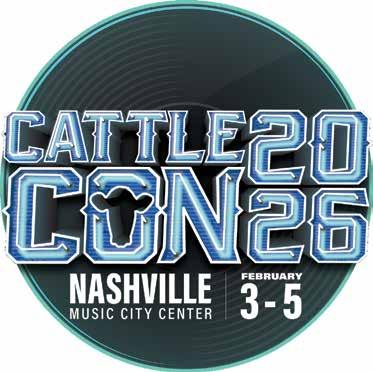


MEMBERSHIP
Kentucky’s Largest County Cattlemen’s Association (Big Bull Award) Winner: Barren County – 490 Members
Top Ten Counties Overall (Cash Prize)
Barren County – 490 Members (Awarded $1,000)
Bath County – 444 Members (Awarded $9,000)
Marion County – 399 Members (Awarded $800)
Shelby County – 368 Members (Awarded $700)
Adair County – 355 Members (Awarded $600)
Christian County – 320 Members (Awarded $500)
Henry County – 309 Members (Awarded $400)
Madison County – 292 Members (Awarded $300)
Grayson County – 275 Members (Awarded $200)
Logan County – 256 Members (Awarded $100)
Top Three Counties per Division in Numerical Membership Increase (Cash Prize)
Division 1
Barren County – 83 Member Increase (Awarded $1,000)
Henry County – 72 Member Increase (Awarded $500)
Clark County – 70 Member Increase (Awarded $300)
Division 2
Allen County – 21 Member Increase (Awarded $1,000)
Mountain County – 16 Member Increase (Awarded $500)
Lewis County – 14 Member Increase (Awarded $300)
Division 3
Pike County – 19 Member Increase (Awarded $1,000)
Bourbon County – 18 Member Increase (Awarded $500)
Campbell County – 13 Member Increase (Awarded $300)
County Presidents Red Jacket - Counties with a 10 or More Membership Gain
Adair – Mark Baker
Allen – Jr. Young
Barren – Dr. Steve Webb
Bath – Jimmy Craig
Bourbon – Stephanie Crouch
Campbell – Chad Bezold
Clark – Ethan Taulbee
Grayson – Ronald Horn
Green – Kerry Davis
Harrison – Keith Smith
Henry – John Allison
Laurel – Mike Calebs
Lewis – Phillip Stamm
Logan – Jared Holloway
Marion – Steve Downs
Mercer – Anthony Godbey
Metcalfe – Harley McIntyre
Mountain – Arch Sebastian
Pike – Matt Hager
Warren – Corbin Cowles
2025 MEMBERSHIP MADNESS AWARDS

From July 28 to Aug. 1, the Kentucky Beef Council Youth Leadership Program traveled across Lexington. With 39 students, including four special visitors from New York and five chaperones, it was a week full of learning, fun and laughter. Student participants will never forget visiting the numerous cattle operations and talking to knowledgeable industry speakers.
On Monday, we began the week with the question “What is leadership?” with our guest speakers Erica and Conner Richardson. Through ice-breaker activities, we learned that leadership is about putting others before yourself and making decisions that benefit everyone. The Richardsons also helped us map out and our future goals and advised us on how to achieve them. This was a great way to get to know each other, as well as plan for our futures. We were then sorted into groups to plan the Beef Chopped Challenge that we conducted on Tuesday. We had to create a meal using 1 pound of ground beef.
The next day, we were split into two groups. Group A went to UK’s kitchen to perform their Beef Chopped Challenge, while Group B conducted a carcass breakdown with Gregg Rentfrow, University of Kentucky meat scientist. Both activities were fun and engaging.
County
During the Beef Chopped Challenge, I learned new cooking skills thanks to Temurbek (Tem) Burikhanov, who oversaw the challenge, who taught us tips and tricks to making a good dish. From enchiladas to cheese fries, we all had amazing ideas on how to use beef.
At the carcass breakdown, Gregg Rentfrow demonstrated how different cuts of meat are made. We learned about short ribs, filets, chuck, sirloin and more! Rentfrow showed us how to make other cuts from some of the cuts listed above. He also identified the internal parts of the carcass and showed us where each cut came from on the cow. I can say with confidence that everyone left UK’s campus knowing more about cooking and meat processing.
From there, we traveled to Tim and Amy White’s farm. They taught us some of the struggles that farmers face with the threat of urbanization growing each and every day. Before their explanation, I never really thought of this issue. However, after listening to them speak on the problems they face, I realized that it was a very real threat that farmers in urban areas face every day. After the tour, they generously catered dinner and allowed us to play games and socialize in their yard.
On the third day, we went to the KCA office and met our keynote speaker,

Steve Isaacs, a UK agricultural economist. He discussed goal planning with us. He taught us the different types of goals and the steps you need to take to achieve that particular goal. He taught us that we need to have SMART goals (Specific, Motivating, Attainable, Relevant and Timed). These are the types of goals that will help you be the most successful.
Then, we went to Malone’s to get a behind-the-scenes tour of their facility. It was incredible to be able to watch our food be prepared in the kitchens, as Malone’s is a favorite restaurant of mine. We learned about all the time and effort it takes to run a large-scale restaurant. I am amazed at the pride they have in their product and the hard work they put into their food quality and customer service.
Our next stop was the UK Research Farm, a farm dedicated solely to research to benefit agriculture and the American farmer. We were once again split into groups and rotated between different speakers. Katie VanValin, an extension beef cattle specialist, taught us about silage, which is chopped up forage stored in an oxygen-free environment. Fermentation preserves all of the nutrients found in the grasses. The bacteria produced lower the pH and stop the silage from spoiling. She also taught us the benefits of using silage with beef cattle. It produces faster than hay, with

Holland Kelsay KBC YLP Participant, Barren

the curing time being quicker than that of hay. Silage is also better for wet and humid weather conditions, like Kentucky summers are known for!
We then transitioned to Eric Vanzant, UK associate professor of animal and food sciences, who showed us the more technological side of farming. We learned that not all AI (artificial intelligence) is a bad thing. With the use of RFID Tags or “smart tags,” we are able to check on our cattle from our living room. With the use of an app, we can log all cattle information and assign each cow a tag. From there, you can check and see how much movement they’re having, how much they are eating, etc. These innovations help farmers and beef producers get data 24/7 on their cattle, no matter where they are. The beef industry and farming as a whole have come a long way, and AI technologies like this one are helping agriculture grow.
Next, we visited with Ron Trotta, UK associate professor of ruminant nutritional physiology, who taught us about the digestive system of ruminant animals. He showed us the four compartments of a sheep's stomach and explained to us what each did. He explained that each compartment helped break down the grass the ruminant consumed through the use of enzymes and stomach acid. The digestive system starts in the mouth. Cattle hardly chew the grass at first, but merely swallow it whole. From the mouth, it travels down the esophagus and into the rumen, the largest compartment of the stomach. The rumen is the fermentation

center that contains bacteria and cellulase, which help break down cellulose contained in the grass. This produces volatile fatty acids, which the cow then regurgitates and then re-chews (cud). This process breaks the grass down before it goes through the other compartments. After passing through the rumen, it goes to the reticulum, which is a filtering and sorting center that traps larger particles that are then regurgitated and chewed again. Smaller particles are passed to the next chamber, the omasum. The omasum is another filtering system that has a water absorption site. The smaller particles that were passed from the reticulum come to the omasum and are further broken down and absorbed by the water. The numerous folds of the omasum’s structure create a larger surface area for water and nutrient absorption. After the particles have gone through the omasum, they then go to the abomasum, the last chamber. The abomasum is often referred to as the “true stomach” because it is most similar to ours and other non-ruminant animals. The abomasum secretes the digestive enzymes and hydrochloric acids to break down the particles, particularly the proteins. This gets the particles ready for further digestion and absorption that takes place in the small intestine. From there, it goes to the large intestine and is secreted out of the body. Trotta also had a microscope with a slide of microbes from the digestive tract.
Our final rotation on Wednesday was with Jeff Lehmkuler, UK extension professor, who demonstrated the process of mixing
feed and the importance of getting your calculations and rations correct. He also stressed the importance of not overmixing the feed, as it causes inconsistency. After we toured UK, we toured the Alltech headquarters. Our tour guide, Anna Burnett, showed us around the facility, explaining the meaning behind the design of the building. I don’t believe any of us were prepared for what lay beyond those doors. It was truly amazing to see how everything had a special meaning; there was so much thought and purpose within every detail of the structure and decorations. We got to see meeting rooms that were specifically designed for different nationalities that come in for business meetings. For example, there was a Chinese-themed room for guests who were from China and an Indian themed room for visitors from India. Anna explained they wanted to make their guests feel like they were at home and wanted them to feel comfortable. Alltech very generously provided us with a documentary, “World Without Cows,” and paid for our meal at the Movie Tavern. The documentary opened my eyes to how important cattle are, not only to America, but to other countries. In India, cattle are sacred animals, and it is illegal to slaughter one. Therefore, when they are at the end of their career, they are released to roam the streets like stray dogs. In Africa, cattle are the very core of their livelihood. Some nomads travel with their cattle every day and rely on them for survival. Together,
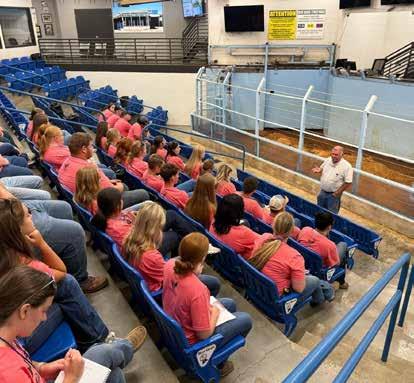
CONTINUED FROM PAGE 47
Brazil and India are home to half a million cattle, all of which play a role in their society and their life. It was stated that “800 million people depend on cattle for their livelihood.” There are 1.5 billion cows in the world. That comes to one cow for every five humans. It would be an understatement to say that cattle are “important” to the world; in fact, they are critical to the survival of so many humans in and out of the United States.
Our morning on the fourth day started with a tour of Elm Tree Farms, a Thoroughbred horse and seedstock cattle operation. Elm Tree Farms is owned and operated by Jody and Michelle Huckabay. Their farm was established in 1989, with the original focus being on Thoroughbred horse breeding. However, it gradually expanded to a 600-acre facility to focus on equine and cattle management. During the tour, we got to see a few of the horse barns, some of which had Thoroughbreds in them. We discussed the significance of the barn designs and how the barns operate. We also got to see some of the cattle that they had in the fields. We learned so much about the horse industry and how much work and time are invested in those horses.
We then traveled to Sparks Farm, where we met with John Sparks and his family. John Sparks is a cattle backgrounder. He discussed with us what that was and how to be successful in the beef industry. He taught us about cattle feeding techniques that he uses, as well as tips on how to get the most ‘bang for your buck’ on raising the cattle for the slaughter. The most important thing we all took away was that
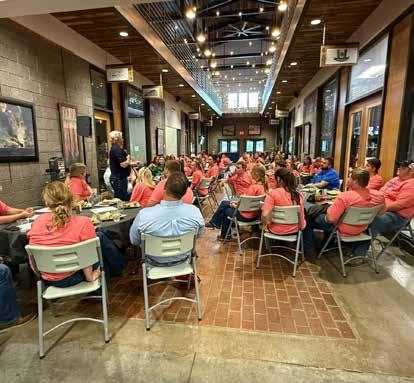
we should give all the glory to the Lord and that everything that we have has come from Him. He also taught us that on a farm, you will make mistakes, but those mistakes teach you common sense, as well as how to face the consequences for your actions. These are the things that will make you a successful farmer.
After that, we traveled to Golden Age Farms, where we met Chris Jackson, the owner-operator. Golden Age Farms is a Wagyu cattle operation that specializes in full-blooded and Wagyu-influenced beef. We toured a couple of their barns and discussed the characteristics of Wagyu cattle. Compared to Angus, we learned that Wagyu cattle handle heat better than Angus, which makes them more sought after on some cattle farms.
Next, we traveled to the Blue Grass Stockyards, where we met Jim Akers, chief operating officer. While there, we learned about the history of the building and the importance it has in the beef industry. They have a sale six days a week, with a total of 400,000 cattle sold on an annual basis. 4,500 head of cattle can be held in the yard, and they can unload eight trailers at one time. While at the stockyards, we had a bull value assessment with Darrh Bullock, UK extension professor. This assessment was designed to help us with the mock bull auction that we were going to conduct at the stockyards the next day. We covered genetics, traits, crossbreeding, heterosis, EPDs and so much more! I never realized how much went into breeding cattle and producing good calves. You have to consider calving ease, growth, carcass weight and management. There are so many things
that you have to look at when breeding a bull and a cow to get the “perfect” calf out of them. Bullock also gave us a pamphlet for us to use and study for our mock bull auction. We were paired together and given a scenario. Our job was to pick the best bull for that scenario for the best price.
On Thursday night, we had a networking dinner at the Blue Grass Stockyards. We met and talked to some amazing people about their journey in agriculture and the beef industry. I think all of us were able to take away something that will stick with us for the rest of our careers in the beef industry.
On our final day of the trip, we went back to Blue Grass Stockyards, where we conducted our mock bull auction. Our auctioneer for the morning was Josh Jasper, a second-generation auctioneer. This was truly an incredible experience to see how bull auctions are run, especially for someone who has never been to a real auction before. After the auction, we spent the remainder of our time together reflecting and saying our goodbyes.
This was one of the best weeks of my life, and I am so thankful to Bradon Burks, our chaperones, and all the wonderful people I’ve met on this trip for making that happen. I hope we were all able to take away something from the week, whether that be learning how to operate a cattle operation or how to be a good leader- or both! We all have made memories that will last a lifetime, from meeting new people, learning new things, or, for the New Yorkers, trying sweet tea for the first time. I hope this program continues to grow and prosper for the years to come!



Free BQCA Certification Available to Kentucky Producers This September
Jake Harrod Program Coordinator, Kentucky Beef Council
The Kentucky Beef Network and the University of Kentucky Extension are pleased to announce a special opportunity for Kentucky cattle producers: Free Beef Quality and Care Assurance (BQCA) certification during the entire month of September.
The BQCA program was developed specifically for Kentucky’s cattle producers by merging the Kentucky Beef Network and the University of Kentucky’s Cattle Handling and Care Program with the national Beef Quality Assurance (BQA) program. This unique combination goes one step further to provide a holistic program for Kentucky producers, by adding cattle handling and animal care components to the training modules. While BQA focuses on national best management practices, the Kentucky BQCA program adds additional components on cattle handling and animal care, tailored to the needs of producers in our state. The program’s training modules provide producers with valuable knowledge on best management practices for handling cattle, ensuring their well-being, and protecting the safety of the producer. It also reinforces the

principles of producing a safe, high-quality beef supply for consumers. By participating, producers are better equipped to raise cattle responsibly, enhance product quality and strengthen consumer confidence in Kentucky beef and dairy products.
Normally, enrollment in the BQCA program costs $5 for inperson training through a local county extension office, or $10 for online training. However, from Sept. 1–30, the Kentucky Beef Network and UK Extension will sponsor all enrollment fees, making certifications completely free during this promotional period.
Kentucky producers have two convenient ways to take advantage of this offer:
• Online: Visit www. kybeefnetwork.com, click on the Beef Quality & Care Assurance (BQCA) tab, and complete the certification course. When purchasing the course, enter the free code: KYBeefFreeSept to waive all fees.
• In-Person: Contact your local county extension office to learn about upcoming BQCA training opportunities in your area.
Ben Lloyd Whitesville, KY (270) 993-1074 benlloyd0223@gmail.com
Winchester, KY (859) 397-5151 shroutron@aol.com
Kevin Laurent, UK co-BQCA coordinator, expressed excitement about the opportunity, stating, “We are very excited for this partnership for our Kentucky cattlemen to continue to tell their story to consumers through sound management practices.”
The goal of the BQCA program is to help producers succeed in today’s market by emphasizing cattle well-being, safe handling and responsible management practices. In addition to improving the safety and quality of the beef supply, BQCA certifications build your credibility with buyers, improve the quality of your product, and strengthen consumer confidence in what we raise here in Kentucky. Producers are encouraged to take advantage of this opportunity to complete their certification at no cost. Whether this will be your first time taking the course or you’re just renewing, September is the perfect time to do it. You’ll walk away with practical, sciencebased knowledge you can put to work on your farm right away— and it won’t cost you a thing.
For more information, visit www. kybeefnetwork.com or contact your county extension office.
Cave City, KY (270) 646-5939 dale.embry@yahoo.com
Springfield, KY (859) 805-0724
jacob.settles4@yahoo.com
Charles Embry
Jacob Settles
Ron Shrout
KENTUCKY BEEF NETWORK FIELD ASSOCIATES

Eden Shale Update
Dan Miller Industry Coordinator, Kentucky Beef Network
My goodness, this summer has been hot! I know that us farmers are bad about complaining of the heat in the summer and the cold in the winter, but when you have to endure these conditions all day, it wears on your patience. I know that those of you who work outside are in agreeance with me, but I am going to backup my hypothesis with some data anyhow.
We are blessed to have the Owen County WKU MESONET weather station on our farm. This allows us to have very accurate data for our exact location.
According to the MESONET data, the true summer heat began on June 16 with the heat index reaching 93 degrees. That was followed by a heat wave that lasted from June 22-27, when the heat index was above 102 degrees every day. After that, the remaining days of June all experienced heat indices above 90 degrees.
July did not offer any relief from the baking temps as the month had 19 days that experienced heat indexes above 95 degrees. In fact, there were only three days all month that were below 90. There is no denying that the hottest stretch of summer so far occurred July 24-30. These seven consecutive days all had heat indexes above 100 degrees with the max reaching 106! The only saving grace to the whole thing is that we have received 5 inches of rain in the month of July, which has kept it from turning brown and us being in a drought.
August gave us a brief break on the first weekend, but temps have quickly returned to normal since then. We are currently in another seven day stretch of heat indexes over 90 degrees, and we are not even two weeks into the month. But it is August, and they don’t call it the dog days of summer for nothing…
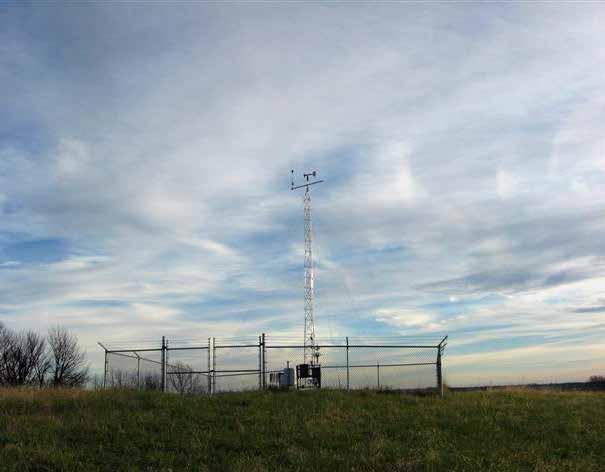
WHO IS RESPONSIBLE FOR REMITTING THE CHECKOFF ASSESSMENT?
BUYER
Generally the Buyer is responsible for collecting the Beef Checkoff assessment from the Seller

SELLER
However, both the Buyer and the Seller are responsible for seeing that the Checkoff is collected and paid. or pays $2 to
QUALIFIED STATE BEEF COUNCIL
Cattlemen’s Beef Board invests in national Checkoff programs, while Kentucky Beef Council invests in state programs.
If you are a producer from one of these seven states - Alaska, Connecticut, Maine, Maryland, Massachusetts, New Hampshire, and Rhode Island - you will remit directly to the Cattlemen’s Beef Board. If you have any questions regarding who is responsible for remitting the Checkoff assessment or how to remit payment, please contact your State Beef Council or the Cattlemen’s Beef Board at (303) 867-6304.
3 Exceptions to Beef Checkoff Collection: 1. Non-producer status: If a person (or company) owns cattle for 10 days or less, purchases the cattle to facilitate the transfer of ownership to a third party, and certifies that any Checkoff dollars due from the previous owner have been collected, then that person qualifies as a “Non-Producer” and the Checkoff assessment is not due when qualified cattle are resold. 2. Organic Exemption: In the 2002 Farm Bill, Congress created a process exemptiing organic producers from paying Checkoff program assessments. 3. Pre-Payment: Producers can also choose to “prepay” the Checkoff assessment when shipping cattle out of state for feeding and still retain ownership on the cattle. This allows the producer to direct half of the $1-per-head national Checkoff assessment to the beef council in the state where the cattle were raised, rather than the state where the cattle will be fed. Note: To claim any of these exemptions, the person selling the cattle must provide the proper ‘document’ to show that the Checkoff assessment is not due at the time of sale. Thus, the rule of thumb for all cattle sales is that the person paying the producer should collect either a “Dollar or a Document.”
LIVESTOCK MARKET - When cattle are sold through a livestock market or video market, the Market collects and remits the Beef Checkoff assessment.
CATTLE DEALER/ORDER BUYER - When cattle are sold to a Cattle Dealer or Order Buyer, the Dealer/Order Buyer collects and remits the Beef Checkoff assessment.
ANOTHER PRODUCER - Both the Buyer and the Seller are responsible for making sure that the Beef Checkoff assessment is collected and remitted. For clarity and consistency, we encourage the Seller to take on this compliance responsibility.
VEAL GROWER - When dairy calves are sold to a Veal Grower, both the Buyer and the Seller are responsible for making sure that the Beef Checkoff assessment is collected and remitted. For clarity and consistency, we encourage the Seller to take on this compliance responsibility.
CATTLE SHOWS AND FAIRS - When producers sell their animals at fairs or cattle shows (4H/FFA shows, Purebred cattle shows, etc.), the Organization that runs the sale collects and remits the Beef Checkoff assessment.
FEEDLOT - When cattle are sold directy to a feedlot, the Feedlot collects and remits the Beef Checkoff assessment.
PACKING PLANT - When cattle are sold to a packing plant, the Packing Plant collects and remits the Beef Checkoff assessment.
DIRECT-TO-CONSUMER BEEF SALES - When producers market their cattle as beef, the Producer is responsible for remitting the Beef Checkoff assessment.
According to the Paperwork Reduction Act of
an agency may not conduct or
person is
to a
it
to
The
for this
of
and
control
OMB control
collection is 0581-0093. The time required to complete this
collection is estimated to
per response, including the
one
for reviewing instructions, searching existing data sources, gathering and
the
and completing and reviewing the
of
The U.S. Department of Agriculture (USDA) prohibits discrimination in all its programs and activities on the basis of race, color, national origin, age, disability, and where applicable, sex, marital status, familial status, parental status, religion, sexual orientation, genetic information, political beliefs, reprisal, or because all or part of an individual’s income is derived from any public assistance program. (Not all prohibited bases apply to all programs.) Persons with disabilities who require alternative means for communication of program information (Braille, large print, audiotape, etc.) should contact USDA’s TARGET Center at (202) 720-2600 (voice and TDD). To file a complaint of discrimination, write to USDA, Director, Office of Civil Rights, 1400
Kentucky Hereford Association


Toby & Debby Dulworth 2492 S. Kirkman Road LaCenter, KY 42056 (270) 224-2993 • dogwood@brtc.net Herefords that thrive on forages. www.dogwoodherefords.com

HEREFORDS
Codee Guffey • 1815 Grassy Springs Road Versailles, Kentucky 40383 (502) 598-6355 rockridgeherefords@gmail.com www.rockridgeherefords.com
TK4 Herefords
Tony & Kathy Staples 992 Knotts Road Brandenburg, KY 40108 (270) 945-9277 (270) 422-4220
tstaples@bbtel.com
PILE STOCK FARM
Registered Polled Herefords
HANSELL PILE, JR.
12045 St. John Rd.
Cecilia, KY 42724
270-735-5192
12 miles West of Elizabethtown
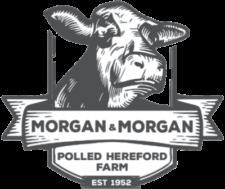
Shannon, Kerry, Emily, Will & Ellie Morgan 13095 Scottsville Rd, Alvaton, Kentucky 42122 www.morganandmorganpolledherefords.com Shannon: (270) 320-2389
Kentucky Hereford Association
KHA Autumn Sale
Saturday December 6th Noon Bluegrass Stockyards Lexington, KY
KHA Certified Hereford Influenced Feeder Calf Sale Thursday December 11th 6pm Bluegrass Stockyards Lexington, KY
WELLS FARM
Polled Herefords
439 Flatwoods Frozen Camp Rd, Corbin KY 40701
Bobby & Brenda Wells (606) 344-0417 wells_farm@yahoo.com
WELLS FARM
Polled Herefords
NJB Limited
439 Flatwoods Frozen Camp Rd, Corbin KY 40701
Dale Stith
KHA OFFICERS
President: Chris Hopper 606-584-7842

Toby & Debby Dulworth 2492 S. Kirkman Road LaCenter, KY 42056 (270) 224-2993 dogwood@brtc.net
Bobby & Brenda Wells (606) 523-0569 or (606) 344-0417 wells_farm@yahoo.com
Kevin, Angela, Kenlea & Kyler Murray (606) 528-1691 or (606) 682-8413
Herefords that thrive on forages. www.dogwoodherefords.com

6077 Helena Road Mayslick, KY 41055
Charlie Boyd II • 606-584-5194 cboyd2@maysvilleky.net www.boydbeef.com
6077 Helena Road Mayslick, KY 41055 Charlie Boyd II 606-584-5194
Annual Bull Sale second
Annual Bull Sale second Saturday in March Hereford and Angus Bulls
Chambliss
Hereford Farms
Chambliss Hereford Farms
Brad, Carla, Clay & Clint Chambliss 1101 Driftwood Lane
Elizabethtown, KY 42701
Home (270) 982-3905
Brad, Carla, Clay & Clint Chambliss 1101 Driftwood Lane Elizabethtown, KY 42701 Home (270) 982-3905 Cell (270) 668-7126 fax 270-735-9922
Cell (270) 668-7126 fax 270-735-9922
www.chamblissherefordfarms.com
www.chamblissherefordfarms.com
WOLF FARM
Registered Polled Herefords Bulls & Females for sale
WCN Polled Herefords
Since 1961
Tim & Peggy Wolf
Bill Norris 2220 Celina Road
12939 Peach Grove Road Alexandria, KY 41001
Burkesville, KY 42717
Home: 859-635-0899 Cell: 859-991-3484
Phone (270) 433-7256
Cell (270) 433-1525
“Every calf needs a white face”

Peyton’s Well Polled Herefords The Lowell Atwood Family 133 Edgewood Drive • Stanford, KY (606) 365-2520 home/fax (606) 669-1455
5239 Old Sardis Pike Mays Lick, KY 41055 dalestith@yahoo.com (918) 760-1550
Kevin, Angela, Kenlea & Kyler Murray (606) 528-1691 or (606) 682-8413

MPH Farms
MPH Farms
Registered Polled Herefords
PAUL L. HANCOCK 8559 KY 56 Owensboro, KY 42301 270-771-4194
Registered Polled Herefords PAUL L. HANCOCK 8559 KY 56 Owensboro, KY 42301 270-771-4194

Jackson Farms
Jackson Farms
Registered Polled Herefords PO Box 215 Cross Plains, TN 37049 615-478-4483
Registered Polled Herefords PO Box 215 Cross Plains, TN 37049 615-478-4483
billymjackson@aol.com
billymjackson@aol.com
“Farming the Same Land Since 1834”
“Farming the Same Land Since 1834”
WOLF FARM

Registered Polled Herefords Bulls & Females for sale
BECKLEY HEREFORDS
Tim & Peggy Wolf 12939 Peach Grove Road
L. Wayne Beckley • 1420 Fitchburg Rd. Ravenna, KY 40472 • 606-723-3021 Cell: 859-779-0962
Alexandria, KY 41001
Home: 859-635-0899
Cell: 859-991-3484
L.W. Beckley D.V.M 284 Pyrse Lane • Irvine, KY 40336 Cell: 859-779-1419 • Clinic: 606-726-0000 www.beckleyherefords.com

Secretary/ Treasurer: Melinda Watson 859-625-8660 melindawatson8660@gmail.com
Dustin Ogburn • 502-686-0522
Secretary/ Treasurer Melinda Watson • 859-625-8660 melindawatson8660@gmail.com
K3 CATTLE REGISTERED HEREFORDS
KYLE BUSH K3CATTLE@YAHOO.COM 859-588-4531
198 HICKS PIKE CYNTHIANA, KY 41031
K3 CATTLE REGISTERED HEREFORDS KYLE BUSH K3CATTLE@YAHOO.COM 859-588-4531 198 HICKS PIKE CYNTHIANA, KY 41031

Polled Hereford and Gelbvieh Cattle 3459 KY Hwy. 1284 E. Cythiana, KY 41031 (859) 234-6956
Polled Hereford and Gelbvieh Cattle 3459 KY Hwy. 1284 E. Cythiana, KY 41031 (859) 234-6956
Ben, Jane, Shelby and Lincoln
Ben, Jane, Shelby and Lincoln
Tony Brandenburg, tstaples@bbtel.com
THOMAS FARM
THOMAS FARM
Eric & Ronnie Thomas 2396 Union City Rd. Richmond, KY 40475 (859) 623-5734
Eric & Ronnie Thomas 2396 Union City Rd. Richmond, KY 40475 (859) 623-5734
Eric’s Cell (859) 314-8256
Eric’s Cell (859) 314-8256
“Cattle for sale at all times”
“Cattle for sale at all times”

BECKLEY HEREFORDS
“Breeding Polled Herefords for over 58 Years”
L. Wayne Beckley • 1420 Fitchburg Rd. Ravenna, KY 40472 • 606-723-3021
Cell: 859-779-0962
L.W. Beckley D.V.M
Windy Hills Farm
Windy Hills Farm
Jackie D. Perkins II 367 Mt. Pisgah Rd. Bremen, KY 42325 (270) 543-3586
Jackie D. Perkins II 367 Mt. Pisgah Rd. Bremen, KY 42325 (270) 543-3586
Breeding to produce good cows since 1981
Breeding to produce good cows since 1981

12 miles
STOCK
Tucker Stock Farms
“Breeding Polled Herefords for over 58 Years”
“Registered Angus and Polled Herefords”
Breeding cattle for sale at all times.
284 Pyrse Lane • Irvine, KY 40336
Cell: 859-779-1419 • Clinic: 606-726-0000 www.beckleyherefords.com
Breeding cattle for sale at all times. 1999 Walnut Hill Rd. Lexington, KY 40515 (859) 271-9086 cell (859)533-3790
WATSON LAND & CATTLE
1999 Walnut Hill Rd. Lexington, KY 40515
John Tucker II 1790 Hidden Valley Lane Hudson, KY 40145 270-617-0301
“Bulls always for Sale”
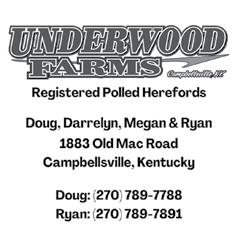
BOYD BEEF CATTLE
6077 Helena Road
Mayslick, KY 41055
Charlie Boyd II: (606) 584-5194
Blake Boyd: (606) 375-3718 www.boydbeef.com cboyd2@maysvilleky.net
BURTON & SONS ANGUS
Joe D. or Karen Burton
ANGUS
THE BUSINESS BREED

927 Old Liberty Pike • Hustonville, KY 40437 (859) 238-0771 • www.branchviewangus.com
James S. & LuAnn Coffey, Donald & Donna Coffey
Annual Production Sale- 2nd Saturday in April

480 Hominy Hill Rd. Nancy, KY 42544
Joe: (606) 305-3081
Located 15 miles West of Somerset • klburton01@windstream.net
Bulls & females sold private treaty. Inquiries Welcome. Sell only what we would buy. Data driven since 1981.
FALL CREEK ANGUS
448 Corder Farm Road
Monticello, KY 42633
Ronnie Corder (606) 348-6588
HILL VIEW FARMS
Jimmy Gilles 5160 Lee Rudy Road Owensboro, KY 42301 (270) 929-5370 jcgilles86@gmail.com
APS ANGUS
4040 Taylorsville Rd
Taylorsville, KY 40071
Gordon Schubert
502-477-2637 • 502-548-8440
Anne Patton Schubert 502-477-2663 • 502-548-2359

TWIN CREEK FARM
HILL VIEW FARMS
(606) 375-3718
ANGUS
Vice
Secretary/Treasurer:

BURKS CATTLE CO. 531 Rick Rd.
Park City, KY 42160
Eddie Burks • (270) 991-6398 www.burkscattle.com
(270) 635-1137
Gibson

COFFEY ANGUS FARMS
661 Hopewell Road Liberty, KY 42539
Matt Coffey: (270) 799-6288
Dewey Coffey: (606) 706-2699
Genetics for Maximum Profitability since 1984

(606)
GREAT MEADOWS ANGUS ASSOCIATION
COFFEY ANGUS FARMS
661 Hopewell Road Liberty, KY 42539
Dale Brown, President 292 Pea Ridge Road Stamping Ground, KY 40439 859-940-8437 www.greatmeadowsangus.com
Matt Coffey: (270) 799-6288

SALES: 3rd Saturday in October • 4th Saturday in April
Dewey Coffey: (606) 706-2699
Genetics for Maximum Profitability since 1984
DAVIS BEND FARMS
LYNN CREEK FARMS
2315 Davis Bend Road Canmer, KY 42722
Kris and Sara Lynn 2184 Bardstown Rd Springfield KY 40069 573-721-6663
FALL CREEK ANGUS
SMITHLAND ANGUS FARM
448 Corder Farm Road Monticello, KY 42633
Ronnie Corder (606) 348-6588
4437 East Hwy 80 Russell Springs, KY 42642
Henry Bryan, Melissa, Bryanna and Blane Smith 606-271-7520 bmsmith@duo-county.com
HAMILTON ANGUS FARMS


Eddie Hamilton 2142 Stilesville Road Science Hill, KY 42553 edjohami@aol.com (606) 271-1286 Bulls and Females for Sale
PLEASANT HILL FARMS
PLEASANT HILL FARMS
Jimmy Gilles 5160 Lee Rudy Road Owensboro, KY 42301 (270) 929-5370 jcgilles86@gmail.com
Shawn, Melissa, Devin & Dylan Gibson (270) 337-3072 or (270) 692-5304 Dennis & Emily 270/337-2128 or 270/402-4338

RANDOLPH FARM
JOHNSON FARMS ANGUS
Angus Bulls & Females Slaughters, KY
Keith: (270) 635-0723 Reese: (270) 635-1137
6550 Highway 330 Owenton, KY 40359 Carter Randolph: (513) 543-4343 Nick Sarky: (513) 262-9846 patty@randolphfarmoperations.com Bulls Available


Gil, Mary, Corbin, Caroline, and Catherine Cowles 500 Rockfield Richpond Road Rockfield, KY 42274 (270) 843-9021 • Fax (270) 843-9005
HERITAGE FARM
DUTCH CREEK ANGUS FORAGE GENETICS
Lynn 2184 Bardstown Rd Springfield KY 40069 573-721-6663
Doug and Susan Schlosnagle (502) 706-0008
DutchCreekAngus.om
MT. MORIAH ANGUS FARMS
Bob, Kathy, Rob, and Janna Clark (859) 748-5558 1446 Kennedy Bridge Rd. Harrodsburg, KY 40330 Bob: (859)339-2610 • Rob: (859)612-1594 mtmoriahfarms1@gmail.com www.mtmoriahangus.com
HERITAGE FARM
Tom McGinnis 1024 Hinkle Lane • Shelbyville, KY (502) 633-1634, home (502) 633-5100, work (502) 655-0164, cell
FOUR KINGS ANGUS
250 Bright Leaf Dr. • Harrodsburg, KY 40330
Cary & Kim King Carymking@yahoo.com • fourkingsangus.com

jacob.tamme@gmail.com www.tammevalley.com

Cary Cell: (859) 613-3734 • Colby Myers - Purebred Manager
timmothyljeffries@gmail.com www.davisbendfarms.com Tim: (270) 528-6605 • Leslie: (270) 528-6435 OLD BARK FARM
OLD BARK FARM
370 Ferrill Hill, Buffalo, KY 42716
D
Nathaniel & Darla Denham
Nathaniel(Bub), Sarah, (606) 423-2457 • (606) tripledangus.com
370 Ferrill Hill, Buffalo, KY 42716
Kenley Conner (502) 905-7825
Registered Angus Cattle
Kenley Conner (270) 735-5324 Registered Angus Cattle
TWIN CREEK FARM Shawn, Melissa, Devin (270) 337-3072 or (270) Dennis & Emily 270/337-2128 or 270/402-4338
TRIPLE D ANGUS
Nathaniel & Darla Denham Nathaniel(Bub), Sarah, Ashley Denham (606) 423-2457 • (606) 875-0780 tripledangus.com


CANNON ANGUS
Gil, Mary, Corbin, Caroline, and Catherine Cowles 500 Rockfield Richpond Road Rockfield, KY 42274 (270) 843-9021 • Fax (270) 843-9005 Located 7 miles west of Bowling Green, 1/2
Tom McGinnis 1024 Hinkle Lane • Shelbyville, KY (502) 633-1634, home • (502) 633-5100, work (502) 655-0164, cell
Located 7 miles west of Bowling Green, 1/2 mile off Hwy 68/80
TAMME VALLEY FARM
SMITHLAND ANGUS FARM 5202 East Hwy 80, Russell Springs, KY 42642 Charles “Bud” & Pam Smith: (270) 866-3898 Henry & Melissa Smith: (270) 866-2311
Jacob Tamme, Owner-Operator (859) 583-7134 jacob.tamme@gmail.com www.tammevalley.com & Find us on Facebook!
Mary Jayne and Victoria Cannon 4619 Cherry Grove Rd Flemingsburg, KY 41041 606-748-5420 www.cannonangusfarm.com


KENTUCKY ANGUS ASSOCIATION MEMBERSHIP APPLICATION
Return to: Shayna Gibson 1535 Fallen Timber Road New Castle, KY 40050 • Annual Dues $35
President: Anne Patton Schubert
President: Tom McGinnis
Shayna
SMITHLAND ANGUS FARM
Hwy 80, Russell
Tamme,
TRIPLE
ANGUS
KENTUCKY ANGUS NEWS
Shayna Gibson, Secretary/Treasurer
www.kentuckyangus.org
2025 National Junior Angus Show (NJAS) Scholarship Presentation
The road to success made a major stop in Tulsa as a group of ambitious young cattlemen and women were awarded scholarships from the Angus Foundation during the 2025 National Junior Angus Show. Held in the heart of Route 66, this year’s NJAS celebrated more than just show ring achievements; it also spotlighted the drive, dedication and dreams of Angus youth across the country.

Angus Foundation $2,000 Scholarship
These junior members received the Angus Foundation Undergraduate $2,000 Scholarship at the 2025 National Junior Angus Show Scholarship Presentation, July 2-4. Pictured from left are Jaclyn Boester, Angus Foundation executive director, presenting; Payton Alexander, Nemo, Texas; Alyson Friesen, Arnett, Okla.; Addie Haverkamp, Bern, Kan.; Bryce Hofing, Coatesville, Ind.; Brenlen Humpert, Windthorst, Texas; Ava Leibfried, Platteville, Wis.; Brady Lott, Carmen, Okla.; Jacob Marksbury, Buffalo, Ky.; Jackson McCurry, Colwich, Kan.; Eliza Patchin, Mitchellville, Iowa; Lauren Phillips, Centerville, Iowa; Gavin Rhode, Stewartsville, Mo.; Ben Sellmeyer, Maroa, Ill.; Bryanna Smith, Russell Springs, Ky.; Sawyer Styles, Brentford, S.D.; Grace Tekansik, Minden, Nev.; and Peyton Wood, Montague, Calif. Angus Foundation chairman, right. Since 1998, the Angus Foundation has awarded more than $5.3 million in undergraduate and graduate scholarships to Angus youth.
2012 NJAS-In a League of Their Own-Kentucky Jacob Marksbury, Buffalo, Ky., right, received the 2012 NJAS - In a League of Their Own - Kentucky $500 Scholarship at the 2025 National Junior Angus Show Scholarship Presentation. Pictured presenting the award is Jaclyn Boester, Angus Foundation executive director, left. Joe Bill Meng Memorial Angus Scholarship Lily Jeffries, Canmer, Ky., right, received the Joe Bill Meng Memorial Angus $750 Scholarship at the 2025 National Junior Angus Show Scholarship Presentation. Pictured presenting the award is Tim Jeffries, left.
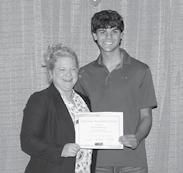
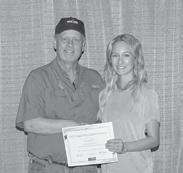
2025 National Junior Angus Showmanship Contest, held in conjunction with the National Junior Angus Show
On Friday evening of the 2025 National Junior Angus Show, 15 junior showmen from across the country stood with bated breath to learn who would
earn the coveted title of Champion Showman. As the lights shone down and the crowd leaned in, one name would soon be called, capping off a week of unforgettable moments along Route 66.

Top 15 Finalists
These outstanding showmen were the top 15 finalists at the 2025 National Junior Angus Showmanship Contest, held in conjunction with the National Junior Angus Show July 3-4. Pictured from left are Suter Clark, Gretna, Va.; Brooklyn Davis, Winchester, Va.; Carter Kornegay, Sperry, Okla.; Tatum Schroeder, Beatrice, Neb.; Kasey Meyer, Blue Hill, Neb.; Carly Sanders, Leesburg, Ohio; Annie Meier, Clinton, Tenn.; Alli Perry, Fayetteville, Tenn.; Naleah Bobholz, Janesville, Wis.; Addison Bartlow, Monticello, Ill.; Emily Caffee, Magnolia, Ky.; Kinleigh Bolin, Walnut Grove, Mo.; Addie Haverkamp, Bern, Kan.; Haley Grace Walker, Potts Camp, Miss.; and Henry Throne, Lexington, Ga. Kentucky
Emily Caffee, Magnolia, represented Kentucky at the 2025 National Junior Angus Showmanship Contest. Forty youth from across the country competed for top honors in the 59th annual event.

All-American Certified Angus Beef® Cook-Off at the 2025 National Junior Angus Show Every recipe has a key ingredient. When it comes to the American Angus Auxiliary’s annual All-American Certified Angus Beef® Cook-off, the key ingredient isn’t the usual suspects — salt, garlic or herbs, but rather family. Now a much-anticipated event at the National Junior Angus Show each July, the event helps young cattle producers develop a better understanding of the consumer eating experience and confidently advocate for beef products.
Senior Roast 1st Kentucky juniors won first place in the senior roast division at the All-American Certified Angus Beef® Cook-Off at the 2025 National Junior Angus Show July 1. Pictured from left are McKenna Jackson, Paris; Lily Jeffries, Canmer; Emily Caffee, Magnolia;
and Emily Jeffries, Canmer. They prepared “ Oaks Day Royale Roast Dinner” and also won top honors in the recipe and showmanship categories. The American Angus Auxiliary sponsored the event.
Senior Ground Beef 1st
Kentucky juniors won first place in the senior other beef division at the All-American Certified Angus Beef® Cook-Off at the 2025 National Junior Angus Show July 1. Pictured from left are Austin Petow, Cynthiana; Colby Cooper, Mays Lick; Kat Branscum, Nancy; and Katy Cooper, Mays Lick. They prepared “Aloha Angus Stacker - Angus Island Luau” and also claimed top honors in the recipe and showmanship categories. The American Angus Auxiliary sponsored the event.
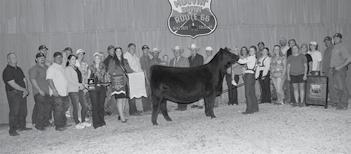
2025 National Junior Angus Show (NJAS)
Over 550 Angus juniors and their families traveled to Tulsa, Oklahoma, to compete in the 2025 National Junior Angus Show June 28-July 5 at Expo Square. National Junior Angus Association (NJAA) members had an exciting road trip “Moovin’ Down Route 66” as they exhibited 925 entries during the weeklong event that included more than a dozen educational contests in addition to the cattle show.
Fourth Overall Owned Champion Female
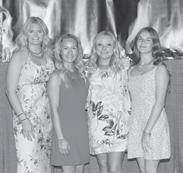
JCC Lola 411 won fourth overall owned champion female at the 2025 National Junior Angus Show. Josie Phillips, Maysville, Kentucky, owns the March 2024 daughter of BRDG Mahogany Prime 904B. She earlier won junior champion--division 3. Jeff Gooden, Oak Grove, Missouri, judged the bredand-owned heifers and bulls, and bred-and-owned and owned cow-calf pairs; Reed Gordon, Warsaw, Missouri, assisted with the bred-and-owned heifers and bulls, and bred-and-owned and owned cow-calf pairs; Charlie Boyd, Mays Lick, Kentucky, judged the owned heifers; Blake Boyd, Mays Lick, Kentucky, assisted with the owned heifers; Scott Greiner, Christiansburg, Virginia, judged the steers; and Ryan Rathmann, Lubbock, Texas, judged the phenotype and genotype bulls and females. A total of 925 entries were shown.
Reserve
Senior Heifer Calf Champion--Division
2
BNWZ Saras Dream 4796 won reserve senior heifer calf champion--division 2 at the 2025 National Junior Angus Show. Josie Phillips, Maysville, Kentucky, owns the winning heifer.
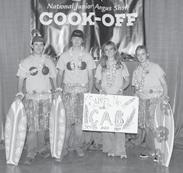


SIMMENTAL
KEVIN AND RACHEL BARRON Crestwood, Ky (502) 905-5851
rkbarron812@gmail.com

SWAIN SELECT SIMMENTAL 12113 Green Valley Dr. Louisville, KY 40243 swainselect.com swainselect@gmail.com facebook.com/swainselectsimmental

Fred & Phyllis: 502-599-4560 Chi & Angie: 502-287-2116

JUDY AND RONDAL DAWSON 1156 Buzzard Roost Road Shelbyville, KY 40065 502-593-5136 • jrdawson22@outlook.com

JEROD METZGER • 270-779-6260

ROCKING P LIVESTOCK 8308 Orangeburg Road Maysville, KY 41056
Chan: 606-584-7581
Keith: 606-584-5626 rockingplivestock@maysvilleky.net
BRIAN & HEATHER SWAIN 3906 Pottertown Road Murray, KY 42071 • 270-293-4440
wksbswain@murray-ky.net


SIMMENTAL AND SIMANGUS BULLS FOR SALE
1939 Huntertown Road
Versailles, KY 40383
BULLS FOR SALE
Chris Allen 859-351-4486 callenuky@hotmail.com
Dr. Henry Allen 859-229-0755


Simmental calves are champions of the scale.
They reliably outperform straightbred calves in the feedyard — with better growth, better structure and fewer health problems.
They add pounds without sacrificing marbling, and they come with the IGS Feeder Profit Calculator, which factors genetics, health and management into true value.
Want low-risk, high-potential calves with earning capability?
406-587-4531 • simmental.org

BRET AND LAURA JACKSON 859.533.3718 or 859.707.7200
BRET & LAURA JACKSON Paris, Kentucky (859) 533-3718 (859) 707-7200

KENTUCKY GELBVIEH ASSOCIATION
AA LAND & CATTLE
KENTUCKY GELBVIEH
Daryl Derossett, President..................................................................................................................(270) 670-6232
Registered Gelbvieh & Balancers
Cynthiana, KY
LARRY CLARK & SONS LLC
Johnnie Moore, Vice President...........................................................................................................(270) 670-7814
Luke Arthur (859) 298-8323
Registered Gelbvieh Cattle
106 Clark Houk Road • Greensburg, KY 42743
Pat Tilghman, Secretary/Treasurer.......................................................................................................(270) 670-8449
luke.arthur93@gmail.com
Bulls • Show Prospects • Embryos Bulls sell with GE EPD’s • Show Prospects
BAR IV LIVESTOCK
Larry Clark, Owner & Operator (270) 299-5167 • (270) 405-6848
Lpclarkandsons@msn.com
Barry, Beth & Ben Racke • Brad Racke • 7416 Tippenhauer Rd. • Cold Spring, KY 41076
BAR IV LIVESTOCK
Barry, Beth & Ben Racke • Brad Racke
CLIFFORD FARMS
Phone (859) 635-3832 • Barry cell (859) 991-1992 • Brad cell (859) 393-3677 • Ben cell (859) 393-3730 Fax (859) 635-3832 • bar4@twc.com
7416 Tippenhauer Rd. • Cold Spring, KY 41076
Phone (859) 635-3832 • Barry cell (859) 991-1992
Brad cell (859) 393-3677 • Ben cell (859) 393-3730 Fax (859) 635-3832 • bar4@twc.com
CD FARMS
BEE LICK GELBVIEHS
Clayton & Debbie Cash 1214 Ottawa School Road • Brodhead, KY 40409 (606)-308-3247 • (606)-758-8994
Eddie Reynolds 277 Old Bee Lick Rd. Crab Orchard, KY 40419
3459 KY HWY 1284E
Cynthiana, KY 41031
Since 1937 (859) 234-6956
BRIAN W. DYER, DVM
Owner/Manager
Gelbvieh-Balancer Bulls & Heifers For Sale by Private Treaty
606-379-2281(H) 606-305-1972(C)
Bulls & Females for sale
BRIAN W. DYER, DVM
Owner/Manager
GELBVIEH/BALANCERS
2050 Glasgow Road • Burkesville, KY 42717
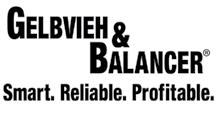

GELBVIEH/BALANCERS
2050 Glasgow Road Burkesville, KY 42717
Brian, Lauren, Kristen Barry, Emily & Julia (270) 864-5909
Brian, Lauren, Kristen Barry, Emily & Julia • (270) 864-5909
PLEASANT MEADOWS FARM
FULL CIRCLE FARMS
Registered Gelbvieh Cattle
Brad Burke 989 Metcalf Mill Road • Ewing KY 41039 (H) 606-267-5609 • (C) 606-782-1367 gbb789@windstream.net
Gary & Pat Tilghman • Carrie & Daryl Derossett Family • Lindsey & Garland Gilliam Family 690 Lick Branch Road Glasgow, KY 42141 270.646.7024 • pleasantmeadowsfarm@hotmail.com
CD FARMS
Registered Gelbvieh & Angus cattle for sale
AA LAND & CATTLE
Clayton & Debbie Cash 1214 Ottawa School Road Brodhead, KY 40409 (606)-308-3247 • (606)-758-8994
R&D OWEN FARMS


KENTUCKY GELBVIEH ASSOCIATION
KILBOURNE GELBVIEH
East Bernstadt, KY
606-843-6583
cell 606-309-4662
LARRY CLARK & SONS LLC
Gelbvieh-Balancer Bulls & Heifers
Johnnie
For Sale by Private Treaty
Pat Tilghman
Registered Gelbvieh & Balancers Cynthiana, KY Luke Arthur (859) 298-8323 luke.arthur93@gmail.com
GELBVIEH & BALANCERS
PO Box 781 • Eddyville, KY 42038 (270) 601-6830 • rdowenfarms.com • sales@rdowenfarms.com
Bulls • Show Prospects • Embryos Bulls sell with GE EPD’s • Show Prospects
S&S GELBVIEH
ASHWOOD SPRING GENETICS
UPCOMING EVENTS
BAR IV LIVESTOCK
Black Replacement Heifers & Bulls Available Embryo transplant & AI sired calves
Registered Gelbvieh Cattle 106 Clark Houk Road • Greensburg, KY 42743
Larry Clark, Owner & Operator (270) 299-5167 • (270) 405-6848
MOCKINGBIRD HILL FARMS
Lpclarkandsons@msn.com
BRIAN W. DYER, DVM
Registered Gelbvieh Cattle
Owner/Manager
GELBVIEH/BALANCERS
BREEDING RED & BLACK POLLED GELBVIEH SINCE 1982
Saturday May 15
Barry, Beth & Ben Racke • Brad Racke 7416 Tippenhauer Rd. • Cold Spring, KY 41076
CLIFFORD FARMS
Shane Wells 10172 Provo Rd. Rochester, KY H: 270-934-2198 C: 270-791-8196 swells@logantele.com
2050 Glasgow Road Burkesville, KY 42717
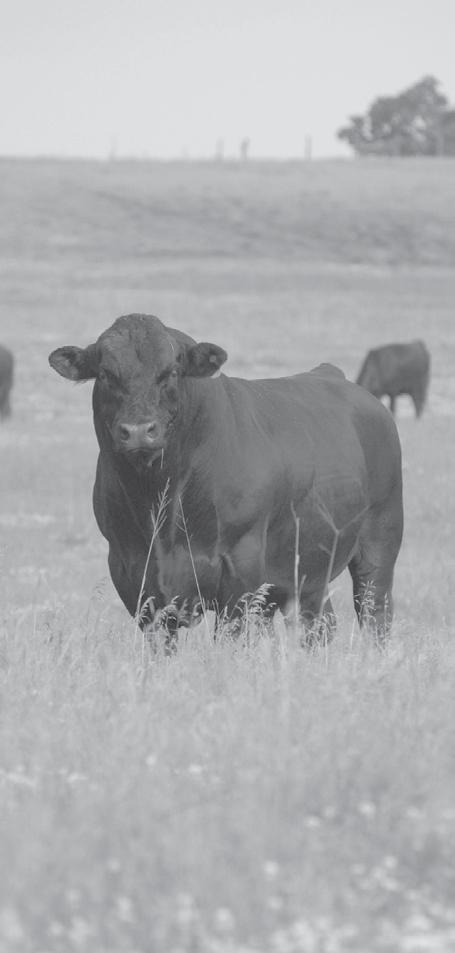
Kentucky Junior Gelbvieh Show & Learning Clinic
Luke & Lindsay Arthur Cynthiana, KY 859-298-8323
Phone (859) 635-3832 • Barry cell (859) 991-1992 Brad cell (859) 393-3677 • Ben cell (859) 393-3730 Fax (859) 635-3832 • bar4@twc.com
McIntosh Brothers Farm • 3348 Frankfort Road • Georgetown 10AM Learning Clinic • 12:30PM Show
Call William McIntosh for more information. (502) 867-3132
3459 KY HWY 1284E Cynthiana, KY 41031
David, Jerri & Jon David: 162 Hastings Ln • Fredonia, KY 42411 (270) 556-4259 Arthur & Joyce Slaughter 19068 Marion Rd • Fredonia, KY 42411 (270)545-3455
Since 1937 (859) 234-6956

Brian, Lauren, Kristen Barry, Emily & Julia (270) 864-5909
FULL CIRCLE FARMS REGISTERED GELBVIEH CATTLE
BAR IV LIVESTOCK
BEE LICK GELBVIEHS
Eddie Reynolds
FULL CIRCLE FARMS
Brad Burke: 989 Metcalfe Mill Rd, Ewing, KY 41039 (H) 606-267-5609 (C) 606-782-1367 gbb789@windstream.net
Friday May 28 - May 30
Barry, Beth & Ben Racke • Brad Racke 7416 Tippenhauer Rd. • Cold Spring, KY 41076
BRIAN W. DYER, DVM Owner/Manager
Registered Gelbvieh Cattle

277 Old Bee Lick Rd. Crab Orchard, KY 40419
606-379-2281(H) 606-305-1972(C) Bulls & Females for sale
Phone (859) 635-3832 • Barry cell (859) 991-1992 Brad cell (859) 393-3677 • Ben cell (859) 393-3730 Fax (859) 635-3832 • bar4@twc.com
AGJA Eastern Regional Junior Show “Run for the Roses” Burley Fields Livestock Center • 709 Oil Fields Road • Horse Cave
Cattle for sale at all times.
Call Carrie Derossett for more information. (270) 404-0828
Entry and room information available at www.gelbvieh.org (Juniors/Regional Shows/AGJA Eastern Regional)
BEE LICK GELBVIEHS
GELBVIEH/BALANCERS 2050 Glasgow Road Burkesville, KY 42717
PLEASANT MEADOWS FARM
Brian, Lauren, Kristen Barry, Emily & Julia (270) 864-5909
Brad Burke 989 Metcalf Mill Road • Ewing KY 41039 (H) 606-267-5609 • (C) 606-782-1367 gbb789@windstream.net
Gary & Pat Tilghman
Lindsey Tilghman Jones Family
FULL CIRCLE FARMS
RICH HILL GELBVIEH
HEDGESPETH LIVESTOCK GELBVIEH/BALANCER CATTLE-COMMERCIAL HEIFERS 543 Pleasant Run Church Road • Campbellsville, KY 42718 sam.hedgespeth@gmail.com • Sam-270.299.5449 Seth-270.932.1615 Dan-606.686.1679 Andrew-270.405.1990
Eddie Reynolds
277 Old Bee Lick Rd. Crab Orchard, KY 40419
PADON FARMS
606-379-2281(H) 606-305-1972(C) Bulls & Females for sale
CD FARMS
Registered Gelbvieh Cattle
Carrie & Daryl Derossett Family 690 Lick Branch Road Glasgow, KY 42141 270.646.7024 • pleasantmeadowsfarm@hotmail.
Frank McAninch 1341 Iven Godby Road Liberty, KY 42539
Brad Burke 989 Metcalf Mill Road • Ewing KY 41039 (H) 606-267-5609 • (C) 606-782-1367 gbb789@windstream.net
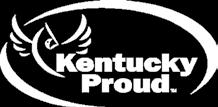
606-787-0120
richhillfarm@windstream.net
KILBOURNE GELBVIEH

Clayton & Debbie Cash 1214 Ottawa School Road Brodhead, KY 40409 (606)-308-3247 • (606)-758-8994
BRAY’S GELBVIEH CATTLE
GELBVIEH BULLS & FEMALES FOR SALE 1012 Shelby Road • Salem, KY 42078 Thad Padon (270) 836-5518
Niles & Betty K Bray 1568 Bray Ridge Road Bedford, KY 40006 (502) 255-3584
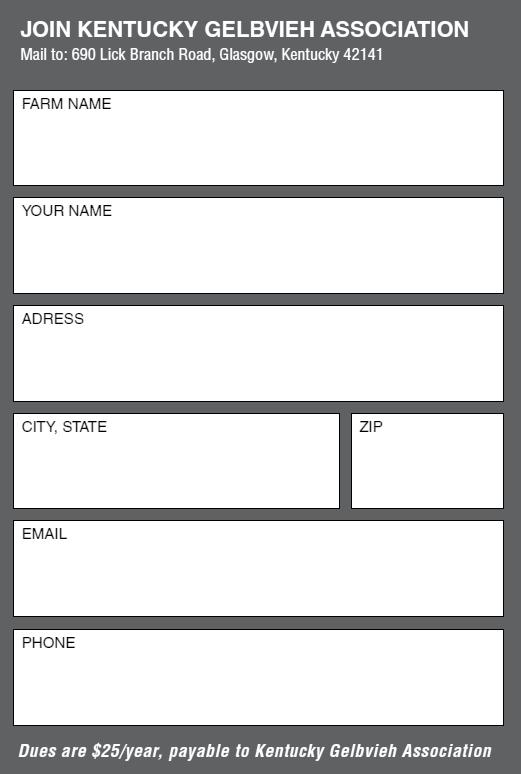
Gelbvieh-Balancer Bulls & Heifers For Sale by Private Treaty
SEP
SEP
SEP 11-13
SEP 12
SEP 13
SEP 20 Beef
SEP
SEP 24
SEP 27
SEP 27 Boyd Maternal Matters Production
SEP 30 Fall Fencing School

SALERS THE BALANCED
BREED
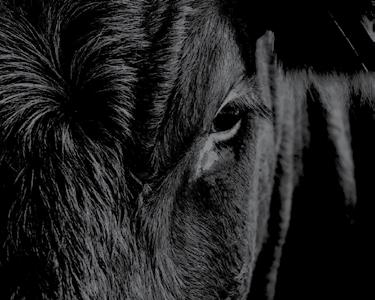
CLASSIFIEDS
REGISTERED RED ANGUS BULLS
FOR SALE * FREE DELIVERY *
FOUR WINDS
PERFORMANCE TESTED PUREBRED ANGUS BULLS FOR SALE Call 270-202-7186 for more info or check out www.oakhollowangus.com for current availability.
POLLED HERFORD BULLS FOR SALE
19–20-month-old Polled Hereford bulls. Good selection. Low birthweight, medium frame. Free Delivery Available. JMS Polled Herefords, Knifley, KY Danny 270-566-2694 Trent 270-566-2000
THE FOUNDATION SALE XI Sat. Sept. 20, 2025 1 pm ct. United Producers, Bowling Green,KY Limousin Fullblood,Purebreed,Limflex. For Info. Call Stephen Haynes 270-799-8685 or 270-799-8684
BULLS FOR SALE Angus and Lim-Flex Yearlings to 2-year-olds Delivery available Call or text 270-589-7999
DIAMOND J SALERS
Donald Johnson • 11660 N. Hwy 1247 • Eubank, KY 42564 606-379-1558
DIAMOND J SALERS
WILLIS FARMS
Donald Johnson • 11660 N. Hwy 1247 • Eubank, KY 42564 606-305-8747
Danny Willis • 964 Johnson Rd • Frankfort, KY 40601 • 502-803-5011 drwc21@aol.com • Purebred + Optimizer Breeding bulls & Heifers for sale.
DEL-SU FARM
WILLIS FARMS
Howard & Sue Edwards • 420 Rose Rd • Somerset, KY 42501 606-679-1675 • Jeriah Privett • 606-416-1154
Danny Willis • 964 Johnson Rd • Frankfort, KY 40601 502-803-5011 • drwc21@aol.com
KNOB LICK FARM - BULLS & HEIFERS FOR SALE
Larry Cox • Tina Cox-Lynch • Amanda Cox Gibson • 1315 Knob Lick Road • Irvine, KY 40336 • 606-723-3077 • 606-975-1716
REGISTERED BLACK SIMMENTAL BULLS
Many blaze faced. Excellent EPD’s. Semen Tested. Delivery Available. Maximize your profit with proven performance. All bulls qualify for new CAIP cost-share. Adam Wheatley 502349-2665
BREEDING AGE HEREFORD BULLS FOR SALE AT ALL TIMES Over 60 years of Line 1 Hereford Genetics. Groups of open and bred heifers available for sale at all times. Chambliss Hereford Farms. 270-668-7126
RED ANGUS, SIMANGUS, CHAROLAIS, ANGUS FOR SALE Red Hill Farms, Lafayette, TN, 615-666-3098 Bart, Sarah and Ty Jones Gordon and Susan Jones, 270-991-2663 Visit us online - www.RedHillFarms.net Contact us for cattle and semen availability. Annual Production Sales: More Than a Bull Sale – 3rd Saturday in March
Maternal Monday – 3rd Monday in May Bulls & Females of Fall Sale – Last Saturday in October
REGISTERED ANGUS BULLS
January-February yearling bulls Semen checked, DNA tested, CAIP eligible, birth weights and EPDS Calving Ease & Growth, BQA Metropolis, IL, 618-638-7693, www. bremerbrothers.com
REGISTERED ANGUS BULLS FOR SALE
Yearlings and 2-Year-Old + Private Treaty Sale Book @ Angus.Org Semen Checked & EPDs Available Randolph Farm, Owenton, KY (513) 262-9846
HOT SEPTEMBER DEALS
New Artex Vertical Beater Manure Spreaders Horning 2/3 row corn header for all makes
John Deere 6715- canopy -2wd
John Deere 5065 4wd loader with cab
H S-Meyer 16-18-20 ft units
John Deere 7320- cab 4wd loader
Sauerburger- 18 ft. batwing
Cloverdale 420t- 500t- mixers in stock
No till Esch 7-10ft drills in stock
Meyer 3954- 2636 manure spreaders
John Deere 4230- cab 2wd
New holland 315-570 square balers
Tye 7ft drill
John Deere 5085e- 4wd no cab 500 hrs. Call Charlie at Red Barn 859-608-9745

Managing the DetailsGetting the Little Things Right
Kevin Laurent Extension Specialist, Department of Animal and Food Sciences, University of Kentucky
Back in the 1980’s one of the stockyards in Baton Rouge, Louisiana, where we sold our hogs had a statement on their check stubs that read, “A man with a paid off cow herd is never really broke.” That simple statement always intrigued me. Given the current market, it seems like a huge understatement, but I think the wisdom of that simple statement can be applied to all stages of the cattle cycle. These historical prices provide an incredible opportunity to pay down debt, improve infrastructure or maybe even expand. Regardless of how we choose to use this additional revenue, we need to be cautious about becoming complacent in our day-today management. Good managers pay attention to detail, and an excellent example can be found in data gathered from the Advanced Post Weaning Value-Added Program (PVAP).
Advanced PVAP is a program of the Kentucky Beef Network and the UK Beef Extension Team. It targets producers who have routinely weaned and preconditioned their calves prior to marketing with the objective of not only evaluating the economics of preconditioning but also identifying the best management practices of these experienced producers. The chart provided is a summary of 52 closeouts from 42 producers that have participated in the Advanced PVAP program to date. As you can see, the
1,645 calves in this summary were fed an average of 79 days postweaning, gained an additional 182 pounds, sold for $7.91 per cwt. over the state average, and netted $221.10 per head over selling at weaning. This type of on-farm data is invaluable not only for producers but also helps us as extension educators provide more effective program planning and recommendations.
To gain even more insight into actual management practices, program organizers conducted a survey of the PVAP participants. Of the 42 producers represented in this database, 41 responded to the survey. Some of the interesting highlights of this survey are as follows:
• 61% used fence line weaning
• 73% introduced concentrate feed prior to weaning either by creep feeding or limited hand feeding
• 78% castrated calves prior to 3 months of age
• 71% implanted their steers
• 78% sold their calves in some type of special preconditioned sale
• 53% fed an ionophore such as Rumensin or Bovatec in either the mineral or feed
• 49% plan to review their management practices based on closeout results
A deeper dive into the database yielded more information on two of the practices highlighted. The first of these showed that how producers marketed their calves affected price received relative to the state average price. Calves selling in special preconditioned sales averaged $9.46 per cwt over the state average. Calves selling in nonpreconditioned sales and/or private treaty averaged $3.25 per cwt over the state average. That’s a difference of $6.21 per cwt.
Another interesting find was the effect that time of castration had on steer average daily gain during the postweaning period. Steers castrated at or near weaning had average daily gains of only .08 pounds more than their heifer mates (2.23 vs. 2.15), whereas steers castrated prior to 3 months of age gained .39 pounds more than their heifer mates (2.49 vs. 2.10). Although not a controlled study, I think we can safely say that the early castrated calves had a weight gain advantage due to less stress at weaning. A conservative assumption of an added .30 pound per day in this example could possibly result in an extra 20-25 pounds per head which in today’s market could be an additional $70-90 per head.
An additional indicator of the level of management by the 41 producers in the survey was the morbidity and
mortality rate among the 1,645 calves. Sickness was reported in only 32 calves (1.95% morbidity). Of these 32 calves, 28 were on the same farm that must comingle calves into one central weaning facility from several different herds. Death loss for the 1,645 calves totaled four head for a mortality rate of 0.24%. It should be noted that two of these calves were from operations that castrate at weaning. The extremely low rate of mortality and morbidity among these 52 different groups of calves further reinforces the argument that the best place for a calf to be castrated and weaned is on the farm where it was born.
Although all the practices highlighted by the survey cannot be necessarily quantified in dollars and cents given the lack of controlled comparisons in this dataset, most of these areas of management have sound economic justification. Most participants in the Advanced PVAP program are embracing these practices to ensure that the calves are ready to transition and thrive at weaning thereby minimizing production risks. But what about market risk? Maybe the next detail our PVAP producers should consider is purchasing Livestock Risk Protection (LRP), especially as we go forward in this extremely high and volatile market.
This is just one example of how managing the details can pay dividends when preconditioning and marketing our calves. I think we would all agree that paying attention to detail and getting the little things right can apply to all areas of management and position our operations for the future. Maybe we can edit that old stockyard check stub to read ,“A person who manages the details and has a paid off cow herd will be ready to ride the next turn of the cattle cycle.”
Spring-Calving Cow Herd
• Bulls should have been removed from the cow herd by now! They should be pastured away from the cow herd with a good fence and allowed to regain lost weight and condition. It is a good time to evaluate physical condition, especially feet and legs. Bulls can be given medical attention and still have plenty of time to recover, e.g., corns, abscesses, split hooves, etc. Don’t keep trying to get open spring cows bred –move them to fall calving or sell them when they wean this year’s calf. If you don’t have a bull pen and want to tighten up the calving season, remove the bull and sell him. Plan on purchasing a new bull next spring.
• Repair and improve corrals for fall working and weaning. Consider having an area to wean calves and retain ownership for postweaning feeding rather than selling “green,” lightweight calves. Plan to participate in CPH-45 feeder calf sales in your area.
• Limited creep feeding can prepare calves for the weaning process since they can become accustomed to eating dry feed. This will especially benefit those calves which you are going to keep for a short postweaning period – like the CPH-45 program. It’s time to start planning the marketing of this year’s calf crop.
• Begin evaluating heifer calves for herd replacements –or culling. Each time you put them through the chute you can evaluate them for several traits, especially disposition. Consider keeping the older, heavier heifers. They will reach puberty before the onset of the breeding season and have higher conception rates.
• This has generally been a reasonably good year for pastures, but many parts of the state are starting to get a bit dry. Evaluate moisture condition and consider stockpiling some fescue pastures. It’s not too late to apply nitrogen for stockpiling fescue if moisture conditions have improved.
• Stresses associated with weaning can be minimized by spreading-out other activities commonly associated with weaning – like vaccinations, deworming and, perhaps, castration and dehorning (which should have already been done!). Therefore, this month is a good time to do a “preweaning” working of cows and calves.
• When planning the preweaning working, consult your veterinarian for advice on animal health products and procedures. One procedure that can be done now is pregnancy checking cows. Early pregnancy diagnosis will allow time to make culling decisions prior to weaning time. Feeding non-productive cows through the winter is a costly venture, so pregnancy diagnosis is one of the sounder business decisions a producer can make.
Fall-Calving Herd
• Fall-calving should start this month. Get your ear tags ready. Cows should be moved to a clean, accessible pasture and watched closely. Tag calves soon after they are born and record dam ID and calf birthdate, etc. Castration is less stressful when performed on young animals, and calves which are intended for feeders can be implanted now, too.
• If you haven’t started calving quite yet, then it’s time to get ready. Be sure you have the following:
• record book or sign up for Stocket (www.Stocket. us or app store). Stocket is a mobile app designed to make record keeping simple and convenient.
• ear tags for identification
• iodine solution for newborn calf’s navel
• calf puller
• castration equipment
• Watch for those calves which may come early and be prepared to care for them.
• Be on guard for predators – especially black vultures.
• Move cows to best quality fall pasture after calving. Stockpiled fescue should be available to these cows in November-December to meet their nutritional needs for milking and rebreeding.
• Start planning now for the breeding season. If using AI, order supplies, plan matings and order semen now.
Stockers
• Calves to be backgrounded through the winter can be purchased soon. A good source is Kentucky preconditioned (CPH-45) calves which are immunized and have been preweaned and “boostered.”
• Plan your receiving program. Weanling calves undergo a great deal of stress associated with weaning, hauling, marketing and wide fluctuations in environmental temperature at this time of year. Plan a program which avoids stale cattle, get calves consuming water and high quality feed rapidly. Guard against respiratory diseases and other health problems.
General
• Keep a good mineral mix available at all times. The UK Beef IRM Basic Cow-Calf mineral is a good choice.
• Do not give up on fly control in late summer, especially if fly numbers are greater than about 50 flies per animal. You can use a different “type” of spray or pour-on to kill any resistant flies at the end of fly season.
• Avoid working cattle when temperatures are extremely high – especially those grazing high-endophyte fescue. If cattle must be handled, do so in the early morning.
• Provide shade and water! Cattle will need shade during the hot part of the day. Check water supply frequently – as much as 20 gallons may be required by high producing cows in very hot weather.
• Plan the winter-feeding program. Take forage samples of hay you will feed this winter. Request protein and TDN analysis so that supplemental feed needs may be estimated. Don’t wait until you run out of feed in February to purchase extra feed. Plan to minimize hay storage and feeding losses because feed is too expensive to waste.
• If you have adequate moisture, stockpiling fescue might be a viable option. Nitrogen application to fescue pastures can be made now and allow them to grow and accumulate until November, or when other sources of grazing have been used up. To make best use of this pasture, put fall-calvers, thin springcalvers, or stockers on this pasture and strip graze.
• Don’t graze sorghum or sudangrass pastures between the first frost and a definite killing frost because of the danger of prussic acid poisoning. Johnsongrass in stalk fields can also be a problem after a light frost. Grazing can resume after the sorghum-type grasses have undergone a killing frost and dried up.
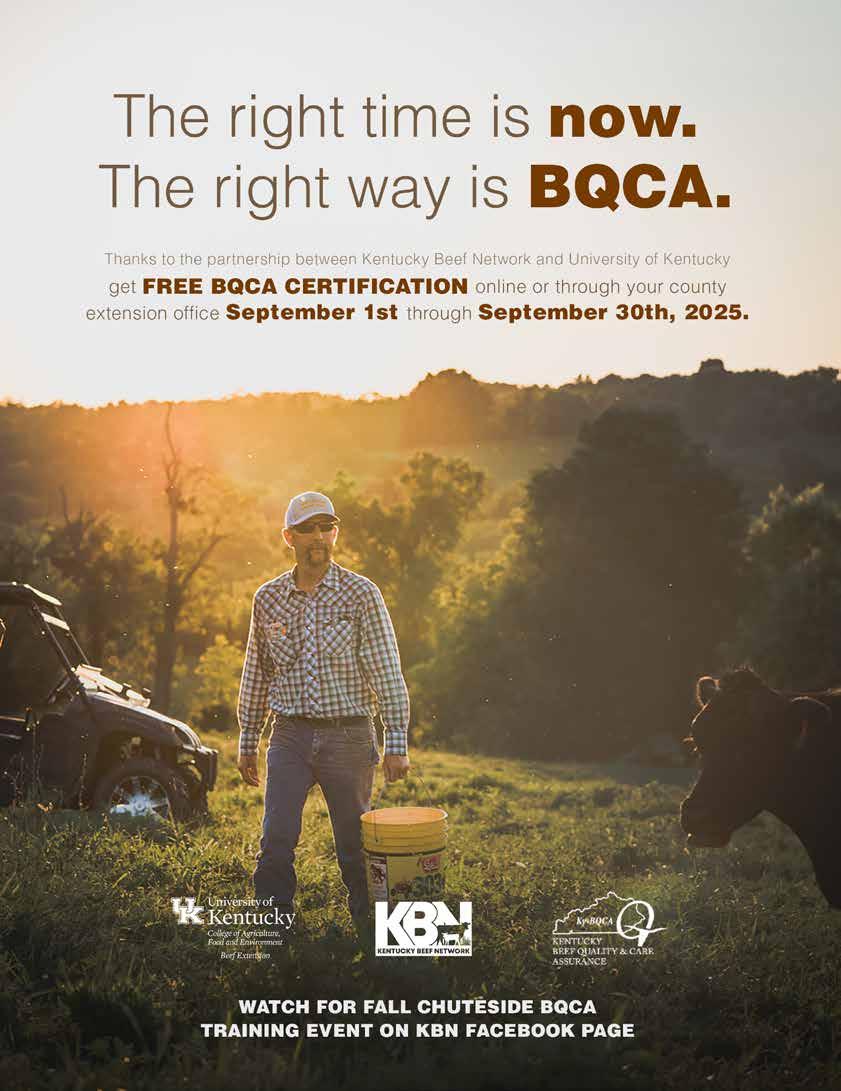

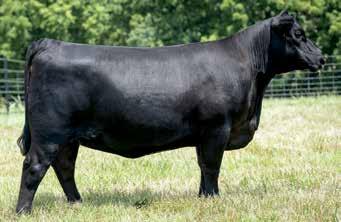

4127

BOYD ABIGALE 4106
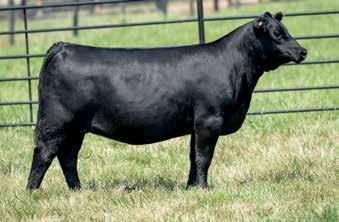
This incredible maternal sister to the ST Genetics Sire, Boyd Salute, is one of many excellent Abigale’s selling! CED

BOYD MADAME PRIDE 5074
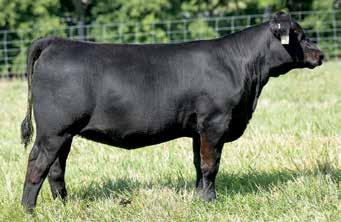
An exciting daughter of the $360,000 Boyd Bedrock – Stylish and massive in her dimension with a neat EPD profile! Her Connealy Mainstay dam also sells safe back to Boyd Bedrock.
BOYD BLACKCAP 4601

This S Armstrong daughter is one of four flush sisters selling – All safe in calf to Boyd Cast Iron! The bred heifers are
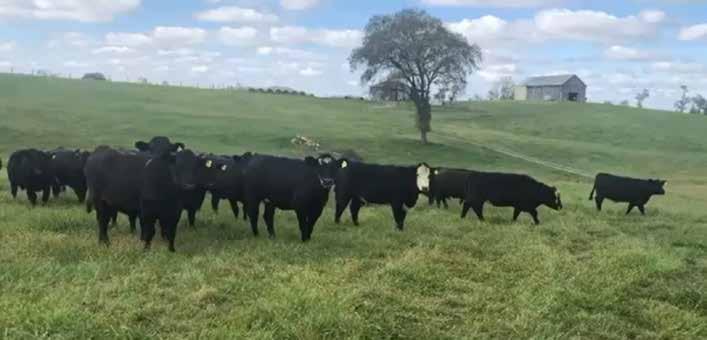

We will have a great selection of bred heifers this fall in 4 different sales. The quality will be excellent and all heifers qualify for CAIP cost share. Quality replacement females are hard to find so don’t pass up this opportunity.
BG East Mt Sterling
Gateway Bred Heifer Sale
October 24 – 6:30 PM
100 head
Farmers Stockyards Flemingsburg
Herd Builder Bred Heifer Sale
November 7 6:30 PM
100 head
BG South—Stanford
Next Generation Bred Heifer Sale
November 15 1:00 PM
150 head
BG Lexington
Blue Ribbon Bred Heifer Sale
December 5 7:00 PM
200 head
BG LEXINGTON
KY Simmental Association Sale
September 27 1:00 PM
Kentucky Stud Wagyu
October 10-11
Millenium Longhorn
October 17-18
R&R Elite Genetics Showcase
October 25 12:00 PM
Trick or Treat at the Yards
October 31 6:00 PM
Profit Thru Performance Feeder Sale
December 3 6:00 PM
Blue Ribbon Bred Heifer Sale
December 5 7:00 PM
Kentucky Hereford Association Sale
December 6 1:00 PM
Kentucky Certified Hereford Influence Sale
December 11 6:00 PM
BG
CAMPBELLSVILLE
Holstein Sale
September 20 1:00 PM
BG EAST—MT STERLING
Gateway Bred Heifer Sale
October 24 – 6:30 PM
FARMERS STOCKYARDS—
FLEMINGSBURG
Herd Builder Bred Heifer Sale
November 7 6:30 PM
BG RICHMOND
Consignment Equipment Sale
October 11 9:00 AM
BG SOUTH—Stanford
Special All Breed Horse Sale
September 12 – Tack 5:00 PM Horses 7:00 PM
Next Generation Bred Heifer Sale
November 15 1:00 PM
Traditions Hereford Influence Fall Feeder Sale
December 4 10:30 AM
